History
Dick Van Dyke’s memoir reveals what it was really like to work with Walt
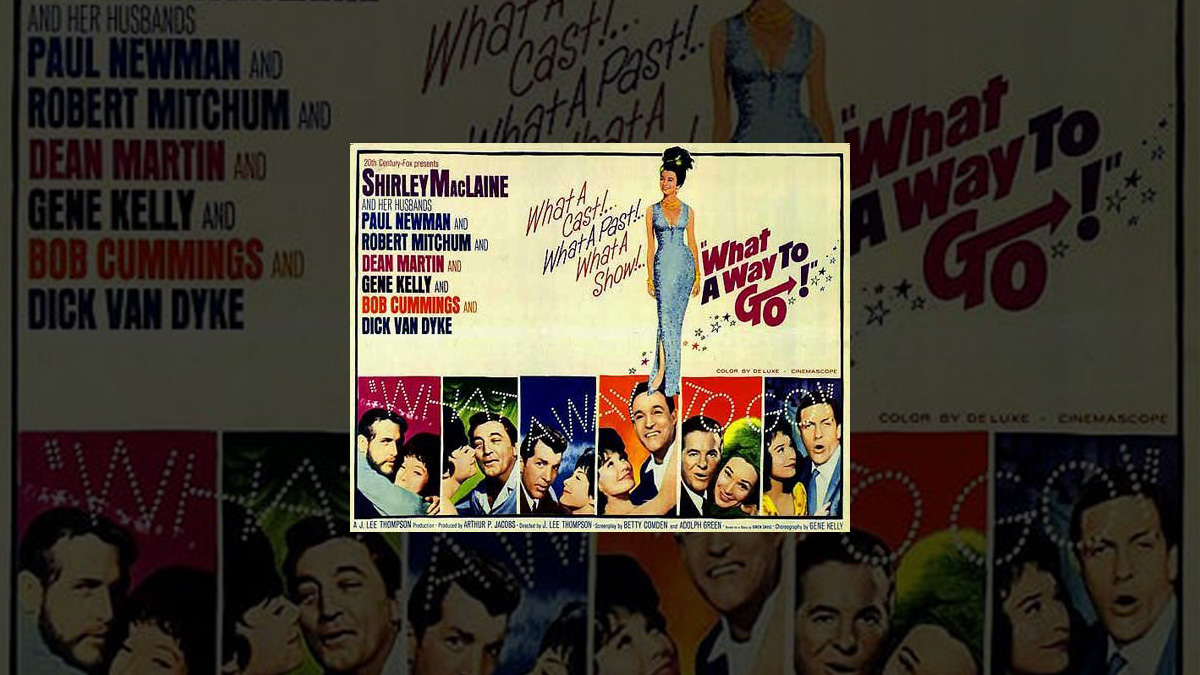
So how exactly did Dick Van Dyke wind up playing Bert in “Mary Poppins” ? According to his just-released memoir, “My Lucky Life In and Out of Show Business” (Crown Archetype, May 2011), Dick landed his role in that Disney
classic because an earlier film of his – 1964’s “What a Way to Go!” – hadn’t
gone quite according to plan.
As Van Dyke explained, that Shirley MacLaine movie’s script …
… had been a pleasure to read, but the final version (of “What
a Way to Go”) included some colorful ad-libbing that made it significantly
different, more adult in tone, and had I known that initially I would have
turned it down.
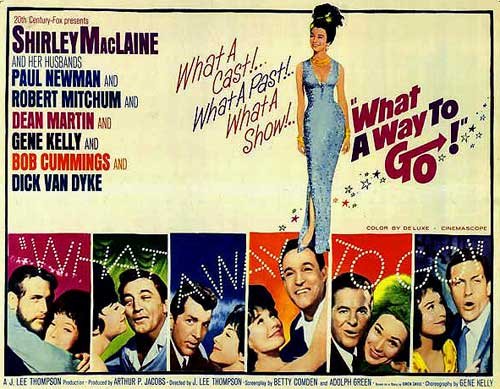
Copyright 1964 20th Century Fox. All rights reserved
I met my agent, Sol Leon, for lunch at the (studio)
commissary, and talked through my concerns. He asked the obvious questions.
What kind of films did I want to make? Where did I see myself going in terms of
movies? What sort of scripts should he look for?
“I’ve thought about this,” I said, “and I’m pretty clear on
it. I only want to make movies that my kids can see.”
“Only kids’ movies?,” he asked.

(L to R) Dick Van Dyke, his son Barry and his grandson Shane on the set of “Murder 101”
“Not kids’ movies,” I clarified. “I want to make movies that
I can see with my kids and not feel uncomfortable.”
So where does Disney enter this equation? Well, as Dick
recalls, Walt …
… read an interview in which I stated my intention to stick to
family movies. He liked that. He thought it made me perfect for his type of
Disney movies – and specifically for the one he was about to start working on,
Mary Poppins.
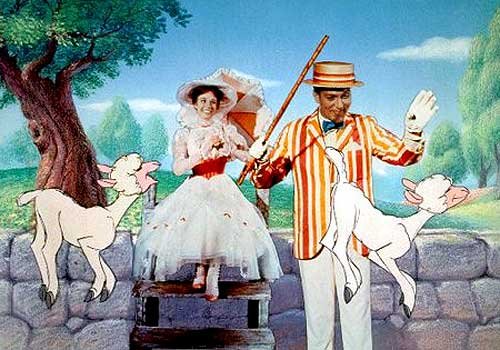
Copyright 1964 Walt Disney Productions. All rights reserved
So how did Walt woo Dick to come play Bert the chimney
sweep? As Van Dyke recounts in this frank but fun show business memoir,
there wasn’t any wooing at all.
There have only been two times in my career where I have
known that I had a chance to be involved in something special. The first was The Dick Van Dyke Show, and the second was when I read the script for Poppins.
I will never forget putting it down, turning to (my then-wife) Margie, and
telling her that (Mary Poppins’ script) was sensational.
Though “My Lucky Life In and Out of Show Business” covers
the length and breadth of Dick Van Dyke’s fabulous career, its highs (i.e. his
multiple Emmy wins for playing Rob Petrie) as well as its lowest (i.e. Van Dyke’s
struggles with alcoholism), the reason that Disneyana fans will immediately want
to run out and buy a copy of this 304-page hardcover is Dick’s
up-close-and-personal take on Walt.
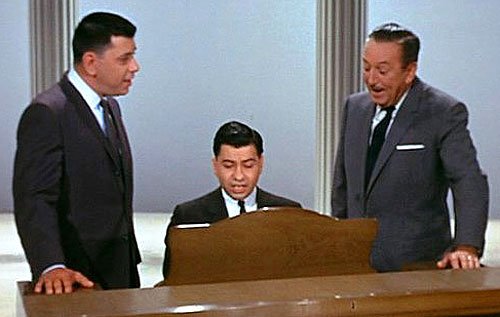
Walt Disney with the composers of “Mary Poppins” score, Robert B. Sherman (L) and
Richard M. Sherman (center). Copyright Disney Enterprises, Inc. All rights reserved
He impressed me as a nice man, really an old shoe. I later
heard that he was a tough taskmaster, but I only saw his easygoing side, the
side that led others to refer to him as Uncle Walt.
Mind you, not all of Van Dyke’s memories of “Mary Poppins”
are fond. The dance rehearsals for that film’s “Step in Time” number sound particularly
brutal.
We practiced on Disney’s back lot for six weeks if not
longer during a heat wave that would have made Moyave feel cool.
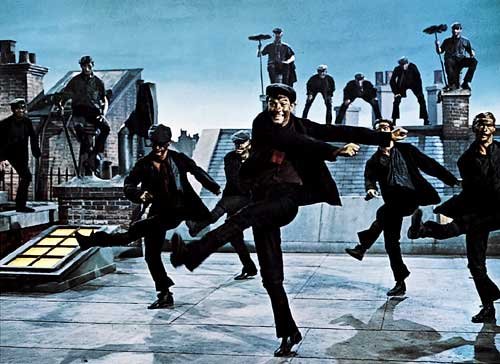
Copyright 1964 Walt Disney Productions. All rights reserved
“I Love to Laugh”
sounds like a difficult number to have worked on as well. But not for the reasons
that you might think. Dick found this number in “Mary Poppins” strenuous to do
because …
… my diaphragm ached from laughing all day. I (actually)
wondered if it might be possible to hurt your diaphragm from too much laughing.
I guessed so. There was also a lot of hanging around in the air on high wires
as lights were adjusted, cameras changed, and retakes done while we were
supposed to be floating high above the floor.
Poor Ed (Wynn), who was in (his) eighties and not well, was
absolutely wonderful and worth the price of admission just to see him going
through various acrobatics …
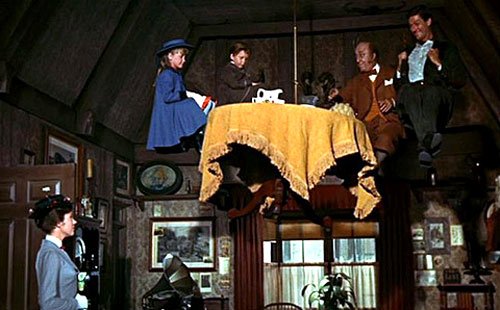
Copyright 1964 Walt Disney Productions. All rights reserved
A couple of times we broke for lunch and the crew started to
leave, forgetting Julie, the kids, Ed and I were all strapped into wires and
hanging thirty feet above the ground. I yelled, “Guys, don’t forget about us.”
There’s a lot of these sorts of stories in “My Lucky Life In
and Out of Show Business.” Which talk about how – through hard work and a lot
of lucky breaks – a kid from Danville, Illinois got the chances to go to Hollywood
and make some truly memorable movies & TV shows. Not to mention meeting many of his screen idols like Cary Grant, Stan Laurel and Buster Keaton.
But you want to know the best part of Dick Van Dyke’s
memoir? Its lack of pretense. Take – for example – the section that talks about
the big budget musical that he made after shooting Disney’s “Never a Dull Moment.”
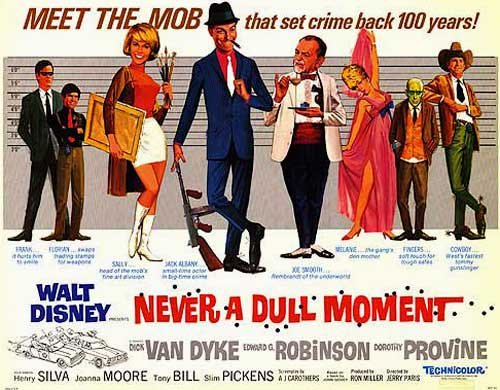
Copyright 1968 Walt Disney Productions. All rights reserved
From there, I went straight into Chitty Chitty Bang Bang, a
movie I repeatedly turned down. Based on Ian Fleming‘s only children’s novel,
it’s the story of an eccentric inventor whose magical automobile is coveted by foreigners
with nefarious intentions. The film’s producer, Albert “Cubby” Broccoli, known
for his tight-fisted control of the James Bond movie franchise, desperately
wanted to re-team Julie Andrews and me.
I can’t speak for Julie’s reasons, but both of us turned him
down. I thought the script had too many holes and unanswered questions.
However, each time I said no, Cubby came back with more money. I’m talking
serious money – more than seven figures, which in those days was mind-boggling,
plus a percentage of the back end, which I never counted on.
I still wanted to say no, but my manager reminded me that
not too many years earlier I was scrambling to win two hundred dollars on
Pantomime Quiz. Although I was in a different position now, I understood – and just
in case I didn’t, he left me know that if I turned down this much money I was
basically declaring myself officially crazy.
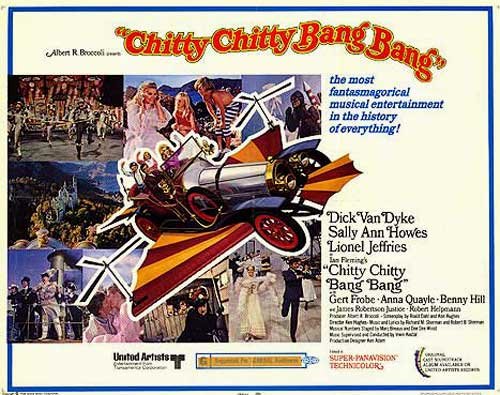
Copyright 1968 United Artists. All rights reserved
After one more round, I finally agreed (to do Chitty).
And you’re a Disneyana fan and/or an entertainment history
buff … Well, you’d have to be officially crazy to pass up the chance to read
Dick Van Dyke’s memoir, “My Lucky Life In and Out of Show Business.” So don’t
press your luck. Go out and buy a copy today.
Your thoughts?
Film & Movies
The Best Disney Animation Film Never Made – “Chanticleer”

This article is an adaptation of an original Jim Hill Media Three Part Series “The Chanticleer Saga” (August 2000).
Creating a “Don Quixote” Disney Animated Film
For over 60 years, Walt Disney Studios has been trying to turn Cervantes’ satiric stories about the Knight of the Rueful Countenance – “Don Quixote” – into an animated feature. Different teams of artists — in 1940, 1946 and 1951 respectively — have taken stabs at the material, only to be tripped up by the episodic nature of Don Quixote’s tale.
In the early 2000s, it looked like the Mouse might actually pull it off. For Disney had assigned Paul and Gaetan Brizzi — best known as the resident geniuses at Disney Feature Animation France — to tackle the project.
(I know, I know. There are a lot of really talented artists who work for Disney Animation. But — trust me, folks — the Brizzis really are geniuses. Do you remember that jaw dropping opening of “Hunchback of Notre Dame”? That was storyboarded by Paul and Gaetan. How about the “Hellfire” sequence from the same film? That was them too. And Stravinsky’s “Firebird Suite” in “Fantasia 2000”? Yep. That’s the Brizzis again. See what I mean? Geniuses …)
Well, Paul and Gaetan labored mightily for months on “Don Quixote,” turning out elaborate and immense storyboards for the proposed film. We’re talking huge pieces of conceptual art here, folks. Three feet by four feet, done all in pencil. Images that took the breath away of even the most jaded of animators.
But all this artistry was for naught. Management at Disney Feature Animation took a look at all the conceptual material the Brizzis had assembled earlier this year. Even though Paul and Gaetan’s storyboards were beautiful, the brass still took a pass on the proposed film.
Why for? A number of reasons, really. Cervantes’ stories — in spite of their fanciful images of windmills turning into giants and humble country inns becoming castles — don’t really lend themselves to animation. Don Quixote’s adventures tend to start and stop a lot. So it’s hard to turn a series of amusing anecdotes into a coherent dramatic narrative.
Plus the Brizzis take on the material? Intense. Dark. Very adult. Their version of the story actually frightened some of the suits in the Team Disney building. So Tom Schneider thanked Paul and Gaetan profusely for their efforts, then quietly pulled the plug on the project.

So all those great inspirational drawings by the Brizzis came down off the cork board, got carefully packed away, then sent off to the morgue … excuse me, “Animation Research Library” (ARL) … and got tucked away in a drawer someplace.
But that’s okay, folks. Because sometimes when they’re feeling creatively blocked, Disney animators will go down to the ARL and start burrowing through the files. What are they looking for? Images that startle. Drawings that inspire. Pictures that make you say “God, what a great idea! I wish I’d thought of that.”
Years from now, animators at the Mouseworks will be saying that very same thing when they come across Paul and Gaetan’s “Don Quixote” artwork. But do you know which conceptual art file Disney’s artists — top animators like Andreas Deja, even — request to see the most nowadays?
Would you believe it was for a Disney animated film that was to have featured fowl?
The Best Film Disney Never Made
Yep, nearly 40 years before Rocky and Ginger made their great escape in Dreamworks SKG / Aardman Animation’s “Chicken Run,” Disney proposed starring chickens in a feature length ‘toon. But these weren’t going to be common English hens. Walt was interested in exotic birds. Parisian poultry.
What was the name of this proposed film? “Chanticleer.” That name alone is enough to make animation historians sigh ruefully. Why for? Because this proposed animated film occupies a very unique spot in toon history. It may just be the best film Disney never made.
Source Material – “Chantecler” by Cyrano De Bergerac
What was the problem here? Well, to understand what went wrong with this proposed film, you have to go back to its source material: Edmond Rostand’s comedy, “Chantecler.” Edmond — best known today as the author of “Cyrano De Bergerac” — stitched together a slight story about a vain little rooster who thought that only his crowing could cause the sun to rise. Though it was set in a barnyard, “Chantecler” was actually a sly satire of pre-World War I French society bean. In spite of its satiric underpinnings (or maybe because of them) Rostand’s play became a favorite with European audiences — where it played to packed audiences for years.

“Chantecler” – 1937 Disney Project
Okay, now we jump to 1937. Walt Disney Studios is just about to finish work on their first feature length animated film, “Snow White and the Seven Dwarfs.” And Disney is casting about for ideas for the company’s next feature length cartoon when someone says “Hey, Walt. You ever hear of that play, ‘Chantecler’?”
Walt gets a quick run-down of Rostand’s plot and likes what he hears. He particularly thinks that the barnyard setting filled with farm animals will lend itself to lots of great gags for the movie. So Disney puts two of his top storymen — Ted Sears and Al Perkins — to work adapting the play to the animation format.
A few weeks later, Sears and Perkins get back to Walt with bad news. Try as they might, they can’t turn Rostand’s play into toon material. Ted and Al gripe that the pre-World War I satire will be too highbrow for American audiences. More importantly, they just can’t come up with a way to make the proposed film’s central character — the vain rooster, Chantecler — into a sympathetic character.
Walt then proposed folding the story of “Chantecler” in with another French fable the studio was toying with animating, “The Romance of Reynard.” This story — actually a collection of eleventh century European folk tales and poems — featured Reynard, a clever fox who was always tricking greedy nobles and peasants out of their ill-gotten gold. After all, what better way is there to make a vain rooster sympathetic than to give him a strong enemy? Someone like — say — a tricky fox?
So Disney’s story people took another whack at adapting “Chantecler” to the screen, this time using Reynard the Fox as the rooster’s enemy. (About this same time, folks at the Mouse House also americanized the name of the project. Which is how “Chantecler” became “Chanticleer”. Anyway …)
But even with the new villain on board, “Chanticleer” still wasn’t quite coming together. Sure, the barnyard setting and the farm animals featured in the story gave Disney’s artists plenty of funny stuff to work with. And they produced plenty of wonderful conceptual drawings for the proposed project. But — in the end — “Chanticleer”‘s story was still very weak and the main characters not terribly sympathetic. So, Walt reluctantly shelved the project.
“Chanticleer” Proposed Revivals
But — in the years ahead — Disney would periodically pull “Chanticleer” off the shelf and ask his artists to take another whack at the material. The project was revived no less than than three different times in the 1940s alone (1941, 1945 and 1947). In fact, many of the drawings done for the late 1940s version of the film provided inspiration for Disney’s 1973 animated feature, “Robin Hood” (Which — not-so-co-incidentally starred a clever fox that tricked greedy nobles out of their ill-gotten gold.)
Still, after all this effort, Disney had yet to turn “Chanticleer” into the makings of a successful animated feature. So — as the 1950s arrived — Walt decided to shelve the project for good (or so he thought). He then turned his attention to other more pressing projects — like Disneyland.
Marc Davis, Ken Anderson, and “Chanticleer”
Okay. Now we jump to early 1960. Ken Anderson and Marc Davis have just about finished work on “101 Dalmatians” and they’re excited. They know they’ve produced a film that really moved feature animation into the modern age. Both through its use of the Xerox process to transfer the animator’s drawings to cels as well as the film’s sketchy layout and design, “101 Dalmatians” is light years ahead of the studio’s previous feature, the stodgy “Sleeping Beauty.”
And the characters! Thanks to the Xerox process, the artistry and power of the lead animator’s original drawings really shines through now. That’s why Cruella seems so vibrant, so theatrical. That’s Marc Davis drawings in the almost raw you’re seeing up there on the screen there.
Marc was eager to build on the theatricality of Cruella. He wanted feature animation to next tackle a project that would allow Disney’s artists to really go for broke. Swing for the fences. Do something that would dazzle and entertain a modern audience.
So what did Marc have in mind? Davis — who was a huge fan of musical theater — wanted to do the animated equivalent of a big Broadway musical. Something with great songs and lots of colorful characters.
Does this sound familiar, kids? It should. Nearly 30 years later, Howard Ashman and Alan Menken actually pulled this off when they collaborated with Disney Feature Animation to create “The Little Mermaid.” That wildly successful 1988 film provided the template for all the animated projects that follow, “Beauty and the Beast,” “Aladdin,” et al. And here was Marc Davis — 28 years ahead of his time — trying to get Disney to do this very same thing. Life’s funny sometimes, isn’t it?
Anywho … So what does one base a big Broadway- style animated musical on? Well, Marc and Ken looked through all of the stories Disney currently had in development — but didn’t find anything that they liked. Which is how they ended up in the morgue … excuse me … “Animation Research Library” … looking at the studio’s abandoned projects.
That’s when Marc came across all the great concept art that had been previously done for “Chanticleer.” Looking over all these colorful drawings of chickens and Reynard the Fox, Davis had a brainstorm. He turned to Anderson and said “You know, I think we could really do something with this …”
But first they had to win Walt over to their idea.
Getting Walt’s Approval for “Chanticleer”
When Ken and Marc told Disney that they wanted to revive the “Chanticleer” feature idea, Walt was initially thrilled. After all, he’d been trying to make a movie made out of Rostand’s play for over 20 years at this point. But then Disney hesitated for a moment.
“What about the plot?,” Walt asked.
“No one’s ever been able to pull a decent cartoon out of this play yet. What are you two going that’s finally going to make this thing work?”
“Simple,” Marc said. “We’re not going to use the play. Ken and I aren’t even going to read the play. We’ll take the bare bones of the story and just make something up.”
It was a pretty audacious way to try and adapt a well-known story to the screen. But Disney loved the idea. (So much so that when the studio began working on a cartoon adaptation of “The Jungle Book,” Walt’s only advice to the story team — after tossing a copy of Rudyard Kipling’s book in the middle of the story conference room table — was to say “Here’s the novel. Now the first thing I want you to do is not read it.”)
Creating an Original Story for “Chanticleer”
So Ken and Marc holed up in an office at Disney Feature Animation for months, doing character sketches and playing with various story ideas. The first thing they did was abandon all the work that the studio had done previously on “Chanticleer.” Their hope was that — by getting a fresh start — they might be able to come up with something original: a light-on-its-feet satiric cartoon comedy. Something similar to Frank Loesser’s 1961 Broadway hit, “How to Succeed in Business Without Really Trying” — a show that made a lot of clever, pointed jokes but never put them across in a mean spirited way.
Chanticleer – The Hero
The film’s hero had to be — obviously — Chanticleer, a well meaning but not terribly bright rooster. He — and all the other chickens that lived in his village — honestly did believe that the sun came up only because Chanticleer’s crowing awakened it every morning. The ladies of the village all swooned at the sight of the handsome young ***. The men in the village all wanted to be his best friend. (Think of Chanticleer as a kinder, gentler version of Gaston from “Beauty and the Beast.”)
In fact, Chanticleer is so well liked that the people of the village decide to elect him Mayor. Naturally, all that power goes to his somewhat empty head. So Chanticleer starts nagging the hens to produce more eggs … which — of course — annoyed the ladies.

Reynard – The Villain
Enter the villain: Reynard the Fox. A shady character in a battered top hat, Reynard has a pencil thin mustache and continental charm. But behind those smooth words and those heavily lidded eyes, this fox is nothing more than a slick con artist — always playing the angles, always on the make.
The Plot of “Chanticleer”
Quickly sizing up Chanticleer’s sleepy village as a fruit — ripe for the plucking, Reynard sweet-talks some of the ladies of the village just so he can learn the lay of the land. The fox quickly ascertains that the chickens are unhappy under the rooster’s stern leadership and that the hens long to have a little fun.
That’s all Reynard has to hear. He slips out of town, only to return the very next day with his dark carnival. Run entirely by creatures of the night (owls, bobcats, moles, etc.) and birds of prey (vultures), the villagers have never seen anything like it. So the chickens stay up all night — singing, dancing and playing games of chance. When morning comes, the hens are entirely too tired to lay any eggs.
Chanticleer views the chickens’ behavior as civil disobedience, as a direct challenge to his authority. So he orders Reynard and his carnival to leave the village at once. The fox responds by saying that he thinks it’s time for a change in leadership in town. That’s when Reynard then announces that he’s running for mayor of the village.
Alright. I know. This doesn’t exactly sound like an award winning plot. And truth be told, it actually gets sillier from this point in: Chanticleer gets suckered into a pre-dawn duel with a Spanish fighting ***. (The Spaniard — as it turns out — is secretly working for Reynard.) Chanticleer is so busy trying not to get killed in this fight that he doesn’t notice that the sun has risen without his crowing that morning.
After the fight, Chanticleer realizes that he’s been a complete ass. He doesn’t control the sun anymore than he can control the other chickens in his village. Yet — because of his sincerity and newly humble nature — the villagers find it in their hearts to forgive him.
Working together, Chanticleer and the rest of the chickens rid the town of Reynard and his dark carnival. From that point forward, Chanticleer becomes the kind, good-hearted, thoughtful leader that the villagers had always hoped he’d be. Every morning, he still crows — not to wake the sun, mind you. But to wake his friends so that they can begin yet another day in their beautiful little French town.
Character Designs and Concept Sketches
Yes. Again, I know. The story sounds silly. Far too thin to support a feature length film. But what you haven’t seen are all the great characters Marc and Ken came up with to people this odd little story. Marc drew literally hundreds of concept sketches which show beautiful French hens decked out in their turn-of-the-century finery. Each of the villagers has a hat, coat or cape. Wearing glasses or clutching canes, they stare up at you — with their bright eyes and wide smiles — out of the concept sketches and seem to scream: “Animate me!”
These stylized characters — with their wonderful period costumes and stylized comic design — would have actually helped Anderson and Davis pull “Chanticleer” off. For Marc and Ken were really hoping to do something ballsy, something original with this film. They envisioned “Chanticleer” as an animated equivalent of a French farce. Something so light on its feet and fiercely funny that you never notice the elephant sized holes in the plot.

Music and Score for “Chanticleer”
Music too would have played a huge part in this film. Marc actually planned for the entire introductory sequence of “Chanticleer” to be done in song. Characters would have entered, literally lugging scenery to help set the stage for the show. Much in the style of Howard Ashman and Alan Menken’s “Belle” opening number for “Beauty and the Beast,” the villagers would have sung about Chanticleer:
“… We love him so, ’cause he brings the sun up, you know …”
Disney to Get Out of the Animation Business
The ironic part of all this was — as Marc and Ken were laboring to create a film that would move Disney Feature Animation into the 1960s — Disney’s accountants were trying to convince Walt to stop making cartoons entirely.
I know that nowadays – when an animated feature can make way over $100 million – it must sound strange that the Walt Disney Company had ever considered getting out of the animation business. But it’s true, kids.
At the time (1960 / 1961), Disney had already produced some 17 feature length animated films. Roy tried to persuade Walt that these were more than enough toon titles to adequately stock the studio’s film library. Studies had shown that Walt Disney Productions could release a different cartoon classics (“Snow White and the Seven Dwarfs,” “Pinocchio,” “Cinderella,” et al) each year and still make a healthy profit off the old movies. So there was really no sense in the company wasting any additional moneys making new animated films.
Shut Down Animation and Create Walt Disney World – Roy’s Attempt
Walt at first strongly resisted this idea. But Roy knew just what cards to play. He had heard that his brother was toying with building another Disneyland somewhere in the United States. Roy also knew that this park — which was supposed to be at least ten times larger that the original Anaheim project — was going to be expensive.
“You’d have all the money you needed to get started on your new park,” the elder Disney suggested, “if you just shut down feature animation.”
Walt again hesitated. For this was truly a tempting offer. All the money he needed to get started on his second park. Plus the cash necessary to fund the project that Disney was really interested in in those days: audio animatronics. Never mind that old, two dimensional stuff in “101 Dalmatians” and “Sleeping Beauty.” The three dimensional animated figures that Wathel Rogers and the other guys at WED were working on — the birds, that Chinaman’s head — that was what really intrigued Walt back then.
Disney had always been a forward thinking guy. He may have loved nostalgia, but he was also eager to tackle new projects, try new things. Compared to audio animatronics, animation did seem kind of old fashioned. But did Walt really dare to shut down Disney Feature Animation?
For weeks, the younger Disney debated the idea with his elder brother, Roy. In the end, Walt just couldn’t bring himself to do it. Walt Disney Productions’ financial security had initially been built on the popularity of the company’s animated movies. To stop making these fine family films entirely would just send the wrong message to the entertainment industry. So it just didn’t seem prudent to totally pull the plug.
Walt Agrees to Scale Back Disney
But what Walt did agree to do was to try scaling back animation production at the studio. Instead of a new animated feature every two years (the pace the company had tried to meet throughout the 1950s), Disney agreed to let Roy reconfigure things so that a new toon would come out once every four years.
The trouble was the studio currently had two animated films in active development: Bill Peet’s adaptation of T. H. White’s Arthurian fantasy, “The Sword and the Stone” and Marc Davis and Ken Anderson’s “Chanticleer.” To meet Roy’s new animation business plan, one of these projects was going to have to be shut down.
Guess which movie hits the cutting room floor?
Cancelling “Chanticleer” – “Sword and the Stone” Moves Forward
Without Bill Peet, Marc Davis or Ken Anderson’s knowledge, Walt brought himself up to speed concerning the current status of both projects. He did this by slipping into the animation building after hours, going into Peet, Davis and Anderson’s offices after they’d gone home for the day and examining all the pre-production art they’d produced for “The Sword in the Stone” and “Chanticleer.
After reviewing all of the conceptual material, Disney quickly came to one conclusion: In spite of the film’s heavy reliance on magic, it looked like “The Sword in the Stone” would be the easier (read that as cheaper) of the two films to produce. It was strictly a numbers thing.
- “Sword”‘s cast was smaller and mostly human — which made its characters easier to draw.
- That film’s story — though episodic in nature — also seemed to have a bit more heart than “Chanticleer.” Wart, from “Sword”, was an underdog that an audience could care about, root for. Chanticleer was … well … a pompous, preening rooster who thought the sun only rose because he crowed every morning. This was not exactly a character that an audience could immediately be expected to warm up to.
- “Sword in the Stone” had no elaborate musical numbers to stage, nor would its characters need big name celebrities to successfully voice their parts.
The final decision seemed like a no brainer. Bill Peet’s “The Sword in the Stone” would be the safer (read this also as cheaper) of the two films to produce.
So Disney would have to pull the plug on “Chanticleer.”
Telling Davis and Anderson
Now came the tough part. Walt was fond of both Marc and Ken. He knew that these guys had labored for the better part of a year in their attempt to turn “Chanticleer” into an animated feature. But Disney just didn’t have the heart to tell them that all of their hard work was for naught, that their film wouldn’t be going into production.
In the end, Walt couldn’t bring himself to tell Davis and Anderson that “Chanticleer” was canceled. So he didn’t. He let a member of Roy’s staff — with a mumbled aside — do the dirty work for him.
The Last Pitch Meeting
Marc knew he was in trouble the moment he saw where Walt was sitting.
Normally — at pitch meetings like this — Disney liked to be down front, dead center. Walt wanted to be as close to the action as possible, ready to leap up and act out a funny bit of business or quickly point out where the project had gone off track.
But Walt wasn’t sitting down front for the “Chanticleer” meeting. He quietly took a seat at the back of the room and avoided all eye contact with Davis and Anderson. The seats in the front row? They were all taken by “Roy’s Boys” — executives who worked on the financial side of the studio.
Marc and Ken quickly exchanged worried glances. But then, gathering his courage, Davis stepped to the front of the room and began his pitch for the proposed animated film.
No sooner had the phrase: “The hero of our story is Chanticleer, a rooster…” left Marc’s lips when one of Roy’s boys muttered to his co-horts: “A chicken can’t be heroic.”
Then Marc knew. 30 seconds into his pitch, “Chanticleer” was already dead in the water. All of Davis’s wonderful character sketches. All of Ken’s beautifully rendered backgrounds. None of that stuff mattered. This movie was never going to get made.
Still Marc pressed on — hoping against hope that he could win this audience over to the idea of doing an all-animated Broadway style musical that starred a chicken. No dice. The people attending this pitch session were polite but indifferent. For they knew what Anderson and Davis didn’t: That Walt had already canceled “Chanticleer.” He just hadn’t gotten around to telling them yet.
When the session was over, those in attendance shuffled out silently — not saying a word.
That includes Walt. Especially Walt.
Fallout from the “Chanticleer” Pitch Session
A week went by and Davis nor Anderson heard nothing from nobody. They just sat in their offices, shell-shocked at how badly the “Chanticleer” pitch session had gone.
Ken’s colleagues at Feature Animation gave these two a wide berth, avoided these two veteran animators like the plague. No one wanted to be associated with a development team that had failed that miserably in a pitch session for a proposed animated feature.
Only Davis and Anderson knew that they hadn’t really failed. They were certain that “Chanticleer” — as they designed it — would have made a wonderful animated film. Sure, it would have cost a bit more to make, taken a lot longer than “Sword” to produce. But audiences would have loved the finished product.
Only this time around, there wasn’t going to be a finished product. For some reason, the accountants — not Walt — were now calling the shots at Walt Disney Studios. And that meant an ambitious, expensive animated feature like “Chanticleer” was never going to make it off the drawing board.
What hurt most was not hearing from Walt. Walt — the guy who’d so strongly encouraged them to take this approach with the material. Walt — the guy who’d seemed so eager to get a “Chanticleer” movie made. Walt — the guy who sat in the back of that pitch session and didn’t say a word.
For a week, Marc waited by the phone — hoping that his boss would call and explain what the hell was happening. Why Roy’s Boys were suddenly deciding which features Disney’s animators could and couldn’t make.
Finally, the phone did ring. And — yes — it was Walt. But there was no explanation. No apology. Just a job offer.
Davis Gets a Job Offer at WED – No Mention of “Chanticleer”
“Marc,” Walt said, “Those guys at WED aren’t very good at staging gags. People have been complaining that Disneyland’s shows have gotten kind of humorless. Do you think you could go over to Glendale and help them out?”
That was it. No “I’m sorry I let the accountants torpedo your film.” No “You and Ken did a really great job. It’s just not the right time to make this movie.” No “That was the best work you guys ever did. I’m truly sorry that we can’t make this movie.” Just “Could you go over to Glendale and help those guys out?”
So Marc — because of his strong sense of personal loyalty to Walt Disney — went over to WED and helped those guys out. And he never returned to Feature Animation.
But — In the 17 years he stayed in Glendale working at Imagineering –Davis helped create some of the greatest theme park attractions the Disney theme parks had ever seen: “The Jungle Cruise.” “The Enchanted Tiki Room.” “It’s a Small World.” “Great Moments with Mr. Lincoln.” “The Carousel of Progress.” “Pirates of the Caribbean.” “The Haunted Mansion.” “The Hall of Presidents.” “County Bear Jamboree.” “America Sings.”
All of them great shows. Each of them displaying that distinctive Marc Davis touch.
But Marc never entirely forgot about “Chanticleer.” It was — to borrow a tired phrase that almost every angler uses — “the big one that got away.” The great film that would have really put a cap on his career as a master animator.
Ah, well … It wasn’t meant to be, I guess.
“Chanticleer” Nods, Easter Eggs, and References
Mind you, this didn’t stop Davis from folding characters and concepts he created for “Chanticleer” into his work at WED. Take another look at those singing chickens in “America Sings.” Do they look familiar? They should. Those birds belting out “Down by the River Side” are modeled after the feathered French hens would who have played the chorus in “Chanticleer.”
And it wasn’t just Marc that kept trying to recycle pieces of this proposed film. His character sketches for the aborted 1960s version of “Chanticleer” were so good, they quickly become the stuff of legends around Disney Feature Animation. Artists would repeatedly go down to the morgue (Excuse me. “Animation Research Library”), pull out the full color, beautifully rendered drawings Marc made for the movie and just marvel at them.
These drawings were so good — in fact — that veteran Disney animator Mel Shaw pulled them out in 1981 to try and sell Disney management on the idea that it was finally time for the studio to make “Chanticleer.” Hoping to improve the proposed project’s chances, Shaw worked up a story treatment that stressed the rooster’s heroic qualities — making him “the most MACHO (chicken) in all of France.”
Mel also threw together an inspiring set of pastel and watercolor conceptual drawings as he tried to sell the studio on making his vision of the film. But the folks running Walt Disney Productions in the early 1980s were more cautious and conservative then “Roy’s Boys” were back in 1960. They quickly shot down the idea of the studio ever doing “Chanticleer” as a full length feature.
When word got out that Disney had once again rejected the idea of doing “Chanticleer” as an animated feature, one man rejoiced. That man’s name? Don Bluth.
Don Bluth and Aurora Productions
Two years earlier, Bluth had made a very public break from the animation operation at Walt Disney Productions. Tired of the heads of the studio constantly cutting corners, always going for the safer choices, Bluth — one of the most talented young animators Disney Studio had at the time — bailed out of Burbank. He left his cozy corporate nest, taking 15 or more of Disney’s top young animators with them.
These folks started a new animation studio, “Aurora Productions.” Their mission: to make great animated films like Walt used to do. Movies like “Pinocchio” and “Bambi.” With strong storylines and full animation. Not tired, half-hearted films like “Robin Hood” and “The Aristocats.”
“The Secret of Nimh”
Right out of the box, Aurora Productions did make a great animated film. Maybe you’ve seen it … “The Secret of Nimh?” This film has everything a hit movie should have: A solid, moving story with superb animation. Characters you care about. Big laughs. Great action sequences. A beautiful score.
Yep, “The Secret of Nimh” had everything that a hit film should … everything except an audience. In spite of receiving tremendous reviews, “Nimh” really didn’t do all that well at the box office and quickly faded from sight.
But still — buoyed by those great reviews (as well as those encouraging phone calls from Spielberg and Lucas) — Bluth remained hopeful. Maybe someday — if he played his cards right — Don might get his shot at turning “Chanticleer” into a great animated film.
“Chanticleer” becomes “Rock-a-Doodle”
For — during his 10 year long tenure at the Mouse House — Bluth too had been down to the morgue (Aw … forget it!) and seen Marc’s drawings. That’s why he knew that a truly fine animated film could be pulled out of Rostand’s barnyard comedy.
10 years later, Don did get his chance at turning “Chanticleer” into a feature length animated film. And while it would be nice to report that Bluth did want Disney couldn’t: turned this French satire into a successful cartoon … that’s not exactly what happened, kids.
What went wrong? Well, for starters, Bluth’s version of “Chanticleer” — entitled “Rock-a-Doodle” — moves the story to America and turns this French vain rooster into … well .. sort of a feathered Elvis.
Then there’s the problem with the villain. Bluth knew that if he borrowed Disney’s proposed antagonist — Reynard the Fox — that it would be too obvious where he had cribbed his original source material from. So Bluth opted to create an all new villain for his “Chanticleer” cartoon: the Grand Duke (voiced by Christopher Plummer), an owl who wanted Chanticleer out of the way so that the sun would never rise again and the world would be forever shrouded in darkness.
Alright, so that’s exactly not the greatest motivation for a movie villain. There’s still lots to like about Bluth’s “Rock-a-Doodle.” Mouse fans will be pleased to hear that old Disney favorites like Phil Harris and Sandy Duncan provide voices for characters in the film. And — as a sly tribute to the original author of “Chanticleer,” Edmund Rostand — Don named the little boy/cat who drives the action in the movie Edmund.
Box Office Indifference for “Rock-a-Doodle”
Unfortunately, audiences in April 1992 (when “Rock-a-Doodle” finally made its stateside debut) weren’t feeling as kindly toward Don Bluth as I did. They greeted the film with indifference. “Rock-a-Doodle” got lousy reviews, did terrible box office and quickly sank like a stone.
So — since Don Bluth Productions turned out such a mediocre “Chanticleer” movie — that’s the end of the story, right? No one will ever again attempt an animated version of Rostand’s play, correct?
Not necessarily.
Andreas Deja
Modern Disney master animator Andreas Deja remains a huge fan of Marc Davis’ conceptual work for “Chanticleer.” In Charles Solomon’s great book about Disney animated features that never quite made it off the drawing board, “The Disney That Never Was,” (Hyperion Press, 1995), Deja is quoted as saying:
Marc designed some of the best looking characters I’ve ever seen — these characters want to be moved and used.
Deja’s obsession with this material continues. In April 2000 — as part of the “Tribute to Marc Davis” that was held at the Samuel Goldwyn Theater in Hollywood — Andreas took a few moments to show the crowd some of Marc’s drawings from “Chanticleer.” As he looked up at the images on the screen, Deja remarked:
It’s kind of sad that this movie was never produced; the studio decided to do ‘Sword in the Stone’ instead. Which is also a very good movie, but wouldn’t it have been nice to see these characters come to life? Apparently, at that time, the studio felt — according to Marc — that it would be too difficult to develop sympathy for a chicken. I don’t think so. I have sympathy for these guys.
Andreas Deja
He added, while still looking up at the pictures, “One of these days, I’ll have to sit down and do a few pencil tests of these characters — just to see them move.”
Maybe one day Disney will put together a test that finally convinces the accountants who are running the Walt Disney Company that there’s a great film to be made from Marc Davis’ “Chanticleer” conceptual material.
Here’s hoping, anyway.
Want more behind-the-scenes Disney stories? Dive deeper into the magic with Fine Tooning podcast, where Jim Hill and Drew Taylor explore animation news and history. Listen now at Fine Tooning on Apple Podcasts. For exclusive bonus episodes and even more insider content, check out Disney Unpacked on Patreon.
History
Why Disney’s Animal Kingdom’s Beastly Kingdom Was Never Built
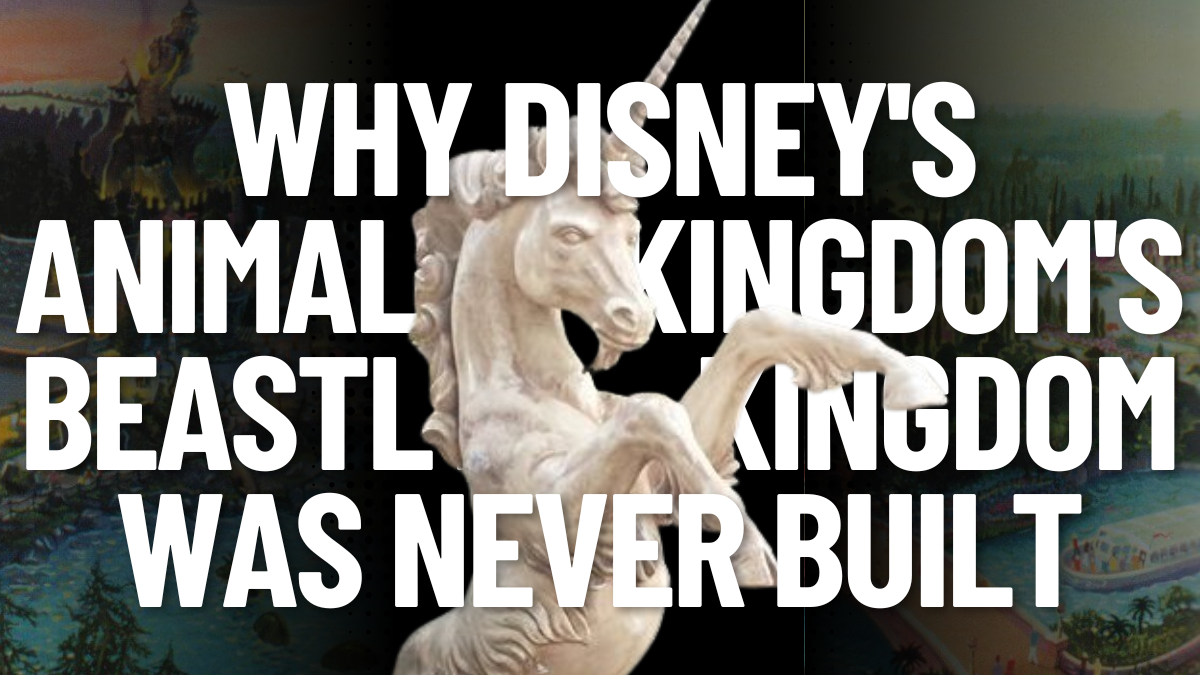
This article is an adaptation of an original Jim Hill Media Three Part Series “Is DAK’s Beastly Kingdom DOA? (December 2000).
You can park your car in the “Unicorn” parking lot.
You can buy your admission ticket at a ticket booth with a huge dragon’s head on it.
And — for a while there — you could even catch a glimpse of a fire-breathing monster as you took a cruise along Discovery River.
So how how come it’s more likely that we will see real unicorns or dragons before the we ever see a “Beastly Kingdom”?
What happened? Why did Walt Disney World decide to scrub its years-in-the-making plans for expansion of its animal theme park? Why table what would seem to be a sure-fire addition to Disney’s Florida resort?
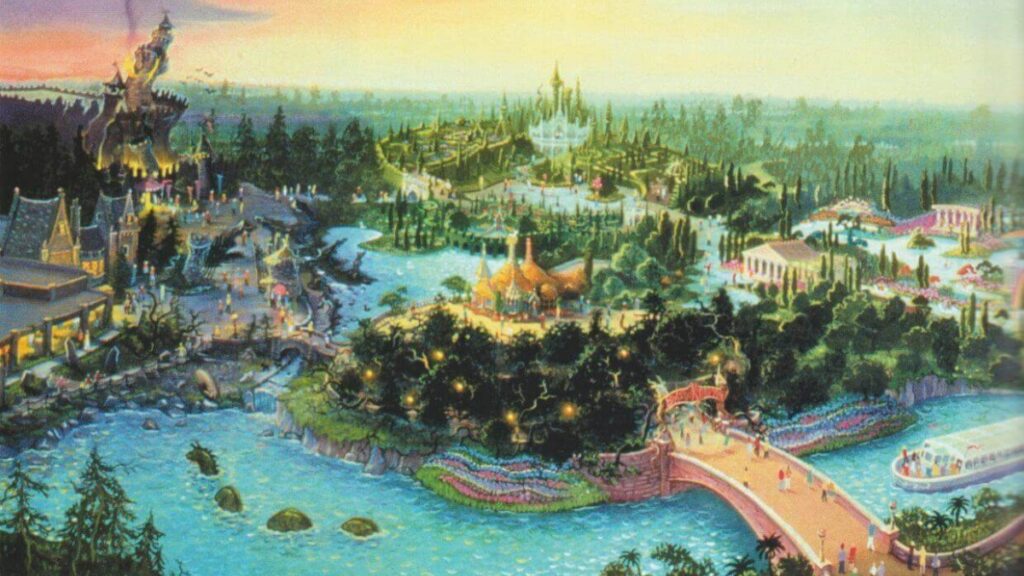
The Price Tag on Building a New Land
Those who have been following the Walt Disney Company’s over the years will not be be surprised to learn that the projected high price tag for building “Beastly Kingdom” factored heavily in upper management’s recent decision to postpone indefinitely any major expansion of Disney’s Animal Kingdom. After all, if times are so tough for the Mouse that they have to lay off the Magic Kingdom’s marching band as well as Epcot’s fife-and-drum corp, what are the chances the company would be willing to spend $200 to $300 million to add a new land to DAK? Slim to none.
Mind you, Mickey was perfectly willing to pony up the $100 million necessary to build the Animal Kingdom Lodge . But that’s different. That’s a hotel. That 1307 room resort starts making money for the Walt Disney Company the moment it opens.
But “Beastly Kingdom?” Exit surveys suggested that — even if Disney went forward with the construction of Beastly Kingdom, Walt Disney World wouldn’t see a large enough increase in attendance at WDW’s fourth theme park to justify the cost of actually building “Beastly Kingdom.”
Guests Wanted to See Unicorns and Dragons at Disney’s Animal Kingdom
The real irony here is that one of the only reasons Disney’s Animal Kingdom ever got built was that way back in 1993, guests who were surveyed about ideas for a fourth WDW theme park responded strongly to the notion of having a place in Florida where they could see unicorns and dragons.
Want to hear what folks were told about “Beastly Kingdom” back then? What follows is an excerpt from an exact transcript of an early marketing presentation on Disney’s Animal Kingdom. It describes in great detail the fun that would have been had in this part of the proposed park:
Beastly Kingdom Marketing Presentation (1993)
Beastly Kingdom is the realm of make believe animals, animals that don’t really exist, out of legends, out of fairy tales, out of storybooks. Like our legends and fair tales about imaginary animals, this land is divided into realms of good and realms of evil.
The evil side is dominated by DRAGON’S TOWER, a burned, wrecked castle inhabited by a greedy, fire breathing dragon. He hordes a fabulous treasure in his tower chamber. The castle is also inhabited by bats who speak to us from their upside down perches. The bats have a plan. They enlist our help trying to rob the dragon and fly us off on a wild chase. At last, we meet the fire-breathing dragon himself and barely escape un-barbecued.
The good side of this land is ruled by QUEST OF THE UNICORN. An adventure which sends us through a maze of medieval mythological creatures to seek the hidden grotto where the unicorn lives. There is also FANTASIA GARDENS. A gentle musical boat ride through the animals from Disney’s animated classic, “Fantasia.” Both the crocodiles and hippos from ” Dance of the Hours” and the Pegasus, fauns and centaurs from Beethoven’s “Pastoral” are found here.
Sounds pretty impressive, yes? Those WDW guests surveyed back in 1993 thought so. They identified “Beastly Kingdom” — with its mix of roller coasters and imaginary animals — as the number one reason that they’d want to visit this proposed fourth theme park.
Opening Disney’s Animal Kingdom is Real Animals
So why wasn’t “Beastly Kingdom” part of Disney’s Animal Kingdom when the park opened on April 22, 1998?
Again, cost played a big part in delaying construction of this highly anticipated land.
But DAK’s future planning had to be factored in too.
After all, it took the Walt Disney Company three years and $800 million just to get “Phase One” of DAK open. And — since the park’s name actually had the word “animal” in it — the Imagineers felt that opening day guests would want to see some actual live animals. So the majority of DAK’s capitalization was poured into building the Africa and Asian safari areas.
After that … well, someone had to make a decision. Disney’s Animal Kingdom was supposed to celebrate all animals: the live ones, the extinct ones, as well as the imaginary. The African and Asian enclosures would take care of the live animals.
But — in doing that — Disney blew through most of DAK’s initial budget. There was only enough money left to build one more land.
Which should the Mouse go for? Dragons or dinosaurs?
“Dinosaur”, Frustrated Imagineers, and Roller Coasters
In the end, the deciding factor here was the money the Disney Company had already blown on the soon-to-be-released computer animated film, “Dinosaur.” Even back in 1995, the Mouse had already invested upwards of $30 million into production of this movie. (Current estimates suggest that Disney may have spent as much as $150 million to finish this film, making “Dinosaur” even more expensive than James Cameron’s infamously over-budget 1997 epic, “Titanic.” ) Eisner wanted to make sure that Disney’s “Dinosaur” movie made a return on that investment, so he insisted that DAK feature an attraction that heavily hyped the forthcoming film.
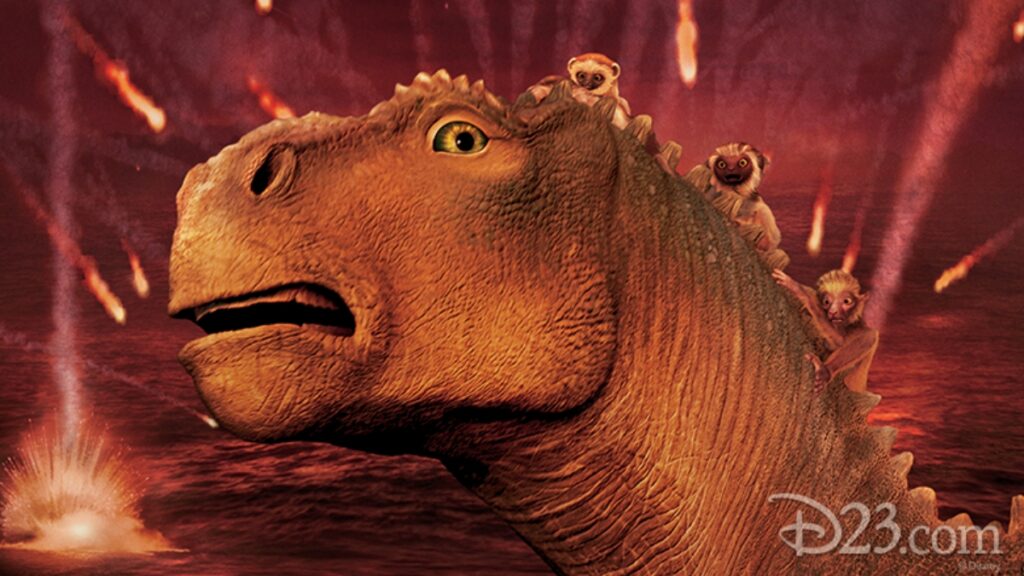
That decision angered Joe Rohde and the other Imagineers on the Disney’s Animal Kingdom project. After all, one of the real reasons that DAK was being built was to keep WDW guests from leaving property to go visit Busch Gardens – Tampa Bay.
And what was Anheuser Busch’s Florida theme park best known for? Its animal displays and its killer roller coasters. With African and Asia, Disney had all the animals it needed. But where were the coasters?
“Dragon’s Tower” at Beastly Kingdom
According to Disney’s Animal Kingdom’s original plans, “Dragon’s Tower” was to have been this park’s signature attraction. That’s why the dragon was featured dead center in DAK’s logo. After guests visited WDW’s fourth theme park, this was going to be the ride they raved about the folks back home about.
What was so special about “Dragon’s Tower?” This high tech thrill ride would have been the Walt Disney Company’s first in-park use of an inverted roller coaster. This attraction would have also featured the largest AA figure ever built for a Disney theme park. The angry jewel encrusted dragon found in the ride’s finale — belching fire and smoke at your car as you zoomed on by — would have easily dwarfed any of the dinos found in “Countdown to Extinction” (AKA the “Dinosaur” ride).
But Eisner insisted that it was more important that DAK feature an area that synergized with the upcoming “Dinosaur” film.
“Beastly Kingdom” would have to wait ’til DAK’s “Phase Two” … which, back then, was to have been completed no later than Spring 2003.
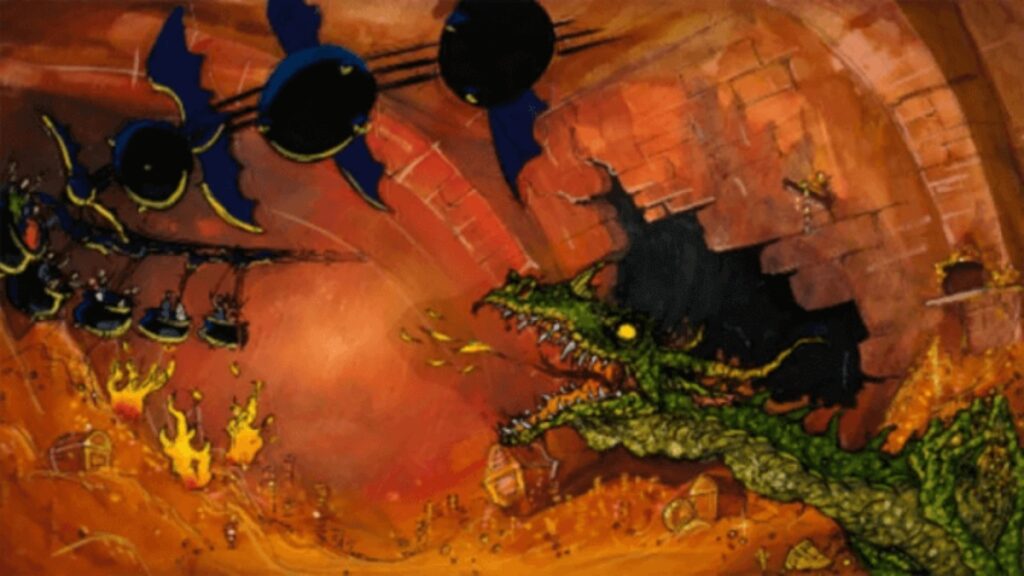
Phase One – “Beastly Kingdom” Easter Eggs
So — with this understanding that “Beastly Kingdom” hadn’t been cancelled, but merely postponed — WDI agreed to scale back their initial plans for Disney’s Animal Kingdom. But, even as they mapped out plans for the “Phase One” version of DAK, the Imagineers deliberately put in some pretty broad hints of the fun yet to come when “Beastly Kingdom” finally opened. That’s why you can park your car in the “Unicorn” lot as well as buy your tickets at the dragon headed ticket booth.
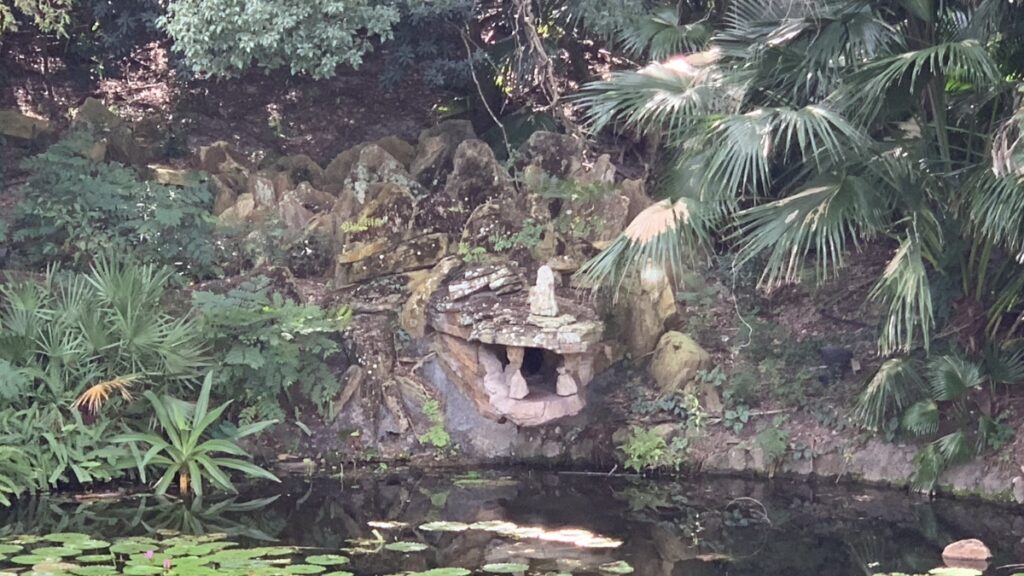
Dragon on Discovery River
As for that fire-breathing dragon found in the cave down along Discovery River … before cost over-runs in other areas of DAK severely cut in the proposed budget for this part of the park, that make-believe monster was just one of many fantastical show elements that would have been found along this part of the river. That whole stretch of Discovery River was supposed to be one big coming attraction for “Beastly Kingdom.”
Had the Imagineers gotten all the money they were originally supposed to get, here’s what you would have experienced after your boat pulled away from the dock and began its cruise around Discovery River:
As you passed under the main bridge leading into Safari Village, you would have seen that the water ahead was littered with the shattered lances and crumpled armor of a great many fallen knights. But what horrible fate could have befallen all of these brave adventurers? A roar from the nearby cave offers a clue.
As your boat floated past the opening of the cave, you would have seen a duplicate of the dragon found in the cavern under Le Chateau de la Belle au Bois Dormant at Disneyland – Paris. Only WDW’s version would have been a lot more active than France’s sleepy monster. This dragon would have craned his neck out of the cave, roared at the guests and then breathed fire their way, before once again settling back down to sleep.
At this point, your boat driver would have started to get nervous. He would explain that he was worried that the dragon’s roaring would awaken the Kracken, a mythical Greek sea monster that was known to lurk along this stretch of Discovery River. Sure enough, the water around the boat begins to bubble ominously.
Off to one side, the huge fin of the Kracken suddenly cuts through the water. As the boat begins rocking back and forth, you’re certain you’re headed for a watery grave. Just then, your captain pulls out a lyre and begins plucking an odd tune. As the boat stops rocking and the water stops bubbling, the captain explains that music puts the Kracken back to sleep. Once that it’s safe to move on, the boat continues to head up river.
Just as you round the bend, your captain points off excitedly to your left. There on the shore, you catch a glimpse of a unicorn. The beautiful white creature — shrouded in mist as it stands in a picturesque grove of trees — paws the earth lightly with one hoof and nods its golden horn our way. The unicorn’s only visible for just an instant, but it truly is a beautiful sight.
As your boat pulls up to the dock in Harambe, you and your fellow guests would still be buzzing about the wonders you would have glimpsed on this leg of your adventure of Disney’s Animal Kingdom …
But of course … this didn’t happen. As DAK’s opening day grew nearer and it became obvious that the whole project was going over budget, great show elements like the Kracken and the Unicorn got cut from the “Phase One” version of the park. In the end, there was only enough money left in the budget for put one creature along the entire length of Discovery River.
Again — because Eisner insisted that “Dinosaur” be heavily synergized at DAK — the Imagineers decided to build a full-scale version of Aladar, the heroic iguanadon from the forthcoming film. That’s the AA dinosaur guests glimpsed roaring and splashing at water’s edge as their Discovery River boat floated past Dinoland USA.
Unfortunately, this decision left the other leg of the Discovery River boat cruise a five minute cruise past nothing. So Joe Rohde begged, pleaded and wheedled … and eventually got Eisner to kick in another couple of thousand dollars. With this tiny chunk of change, Joe was able to get the rock dragon that spews water along this part of the river built, as well as a very stripped down version of the park’s fire breathing dragon.
But don’t go looking for an Americanized version of Disneyland – Paris’s majestic AA dragon to be found along this part of Discovery River. Rohde’s Imagineers did the best they could with zero cash. All you’ll find here now is a somewhat dinky cave at water’s edge. As the boats went by, a ferocious roar would echo out of the cave, followed by a burst of flaming propane. These effects hinted that there was a dragon somewhere deep back inside that cave … but guests never really got a glimpse of the thing.
Discovery River Disappointments
As you might imagine, WDW visitors were pretty unimpressed with what they saw along Discovery River once DAK opened. In fact, this was the ride that guests singled out — right from Opening Day — as the worst attraction in all of Disney’s Animal Kingdom. After waiting in line for over an hour to board the boats, they were furious to find that there was virtually nothing to see along the water during their five minute journey to Harambe.
The Imagineers were obviously embarrassed by this situation. It was particularly frustrating to WDI because they knew that they had a solution to the Discovery River problem, ready to go. But Disney management was too cheap to put up the money to make the fixes.
But that had been typical of Disney management’s handling of the whole DAK project. Given the choice between doing things the right way and the inexpensive way, the Mouse always opted to go cheap.
Disney’s Animal Kingdom Opening Day Capacity Problems – “Camp Minnie-Mickey”
Take — for instance — how the Mouse handled the park’s capacity problems. When it became obvious that Asia was not going to ready in time for Disney’s Animal Kingdom’s April 1998 opening, the Imagineers began warning Disney management that DAK would not have a full day’s worth of shows and attractions. After having paid full price for admission, guests were sure to complain if they only got a half day’s worth of entertainment.
Eisner’s solution? Slap in a temporary land, similar to the “Mickey’s Birthdayland” area that the company had created for WDW’s Magic Kingdom way back in April 1988. From its first conceptual drawing right through to the first guest walking into Mickey’s house, “Mickey’s Birthdayland” had only taken 90 days to install.
Rohde and his Imagineers was appalled at Eisner’s suggestion. But — rather than tell the boss that his idea was terrible and that they wanted nothing to do with it — the DAK design team insisted that they were far too busy supervising construction in the rest of the park to work up any new temporary lands.
So Eisner ordered WDW’s entertainment office to take over the project. Using “Mickey’s Birthdayland” as their template, the entertainment staff came up with the concept for “Camp Minnie-Mickey.” Since there was no money available for even the cheapest of off-the-shelf rides, the WDW team opted to build “Camp Minnie-Mickey” around two low budget stage shows and several no budget character encounter areas.
How quickly and cheaply was “Camp Minnie-Mickey” thrown together? Do the float units the characters perform on in “Festival of the Lion King ” look familiar? They should. They’re the exact same parade floats that Disneyland ran up and down Main Street USA during the three year run of its “Lion King Celebration” parade.
Hope for Joe Rohde and Imagineers in Phase Two
Having this rapidly slapped together area sitting alongside lands that they’d spent years designing really irked the Imagineers. But Rohde advised his team to be patient and hold their tongues. After all, once Disney’s Animal Kingdom opened on April 22, 1998 and proved to be a huge success, then WDI would finally get the time and the money necessary to fix all the stuff that was wrong with the park.
Then the Imagineers could get the chance to put back all the stuff that was cut out of Discovery River. Then they could quietly pull the plug on that monstrosity, “Camp Minnie-Mickey.” Then WDI could finally get around to DAK’s “Phase Two” and build Beastly Kingdom.
Well, April 22, 1998 arrived and Disney’s Animal Kingdom opened …
But — after that — things didn’t quite go according to plan.
Eisner’s Expectations for Disney’s Animal Kingdom
Okay, kids — before we get back to the story of how “Beastly Kingdom” ended up on Disney Animal Kingdom’s (DAK) endangered species list — you need to understand what the Mouse’s original expectations were for its fourth Walt Disney World (WDW) theme park.
Here’s what Disney CEO Michael Eisner had hoped would happen when DAK opened on April 1998:
- Attendance levels would go through the roof at the Magic Kingdom, Epcot, and the Disney-MGM Studios, as a record number of visitors rushed down to Florida to check out WDW’s fourth theme park.
- Guests who had previously stayed on property at Walt Disney World hotels for four days would now book five day vacation packages — just to be sure that they didn’t miss any of the new shows and attractions that had recently been added to the resort.
- All this extra guest traffic would result in increased revenues for WDW’s hotels, shops and restaurants — which would have an immediate positive impact on the Walt Disney Company’s bottom line.
- Eisner and his staff would bask in the glow of the unparalleled success of Disney’s Animal Kingdom for a moment … then get right back to work, brain-storming ideas for WDW’s fifth theme park.
That’s what Uncle Michael had hoped would happen, anyway.
Reality proved to be infinitely harsher.
Walt Disney World Attendance in 1998
In spite of the Mouse’s rosy projections, Disney’s Animal Kingdom — in its first year of operation:
Actually drove down attendance levels at the other three WDW theme parks in 1998.
- 8% fewer guests visited the Magic Kingdom
- 9% fewer went to the Disney-MGM Studios
- Epcot’s attendance levels dipped a startling 11%
What happened? In a word — cannibalism.
How Does Opening a New Theme Park Affect the Other Theme Parks?
“Cannibalism” is the term Disney Company executives use to describe what happens when a brand new theme park opens and begins eating into the attendance levels of the older, more established parks at the same resort.
Epcot Opening
In 1982, when Epcot opened, that park initially cut significantly into the number of guests that annually visited the Magic Kingdom. However — over time — attendance levels at Magic Kingdom bounced back to what they once were after the newness of Epcot had worn off. Meanwhile, Epcot Center began drawing guests all on its own to WDW. In the end, it all worked out just fine.
Disney-MGM Studio Opening
A similar thing happened in May 1989, when the Disney-MGM Studio theme park threw open its gates. For almost a year, attendance levels at the Magic Kingdom and Epcot slumped while guests opted to go to the new WDW theme park rather than visiting their old favorites. But — once again, over time — the situation sorted itself out. Attendance levels at the older WDW parks slowly rose back up to where they once were, as the Disney-MGM Studios began luring millions of new tourists to come see Disney’s Florida resort.
Disney’s Animal Kingdom Opening
The Mouse had been anticipating that — when Disney’s Animal Kingdom opened — that it too would initially bleed guests away from the Magic Kingdom, Epcot, and the Disney-MGM Studios. That’s why Eisner had had the Imagineers add new attractions and/or complete major rehabs to each of the older WDW parks in the 18 months prior to DAK’s opening.
This was Uncle Michael’s brilliant scheme. He honestly believed that — if the Magic Kingdom, Epcot, and the Disney-MGM Studios each had new rides and shows for visitors to see — guests who had come down to WDW just to see Disney’s Animal Kingdom during its first year of operation would still end up of staying on property an extra day or so just to check out all the new stuff at the other parks.
On paper, that really did seem like a brilliant plan. Too bad reality got in the way.
Eisner’s Attendance Plan Doesn’t Go as Planned
What happened to ruin Eisner’s plan? For starters, Epcot’s heavily hyped new thrill ride — GM Test Track — was beset with horrible technical problems and ended up opening a full 18 months behind schedule. So that park really had nothing new to offer to returning WDW guests the year DAK opened.
Over at the Disney-MGM Studios, a much anticipated addition to the park — “David Copperfield’s Magic Underground” restaurant — never made it off the drawing board because the magician’s outside financing for the project disappeared. It would now be months after DAK’s opening before the studio theme park’s next big attraction — an East Coast version of Disneyland’s “Fantasmic” — would be ready to start entertaining WDW visitors.
As for the Magic Kingdom … truth be told, very little thought was put into to adding new shows and attractions to WDW’s first theme park. The Magic Kingdom had always been the favorite with Disney World visitors. Eisner and WDI felt that — what with the recent “Mickey’s Toontown Faire” redo as well as the 25th anniversary parade that was still running daily at the park — there was still plenty of semi-new stuff to entice people into making a return trip to the Magic Kingdom.
So — given all the money the Walt Disney Company had pumped into the Magic Kingdom, Epcot, and the Disney-MGM Studios to counter-act the effects of DAK’s opening — Eisner had anticipated that the attendance levels at WDW’s older parks would only dip by 5% in 1998. He was said to be furious when — almost across the board — attendance fell by almost twice that amount at all three of the other WDW theme parks.
This news immediately put WDW’s management team into crisis mode. The big boys in Burbank wanted attendance levels at each of the older WDW parks driven back up immediately. The managers of the Magic Kingdom, Epcot, and the Disney-MGM Studios reminded Eisner and Company that — in order to do that — they’d need money fast for new shows, parades and attractions. Eisner immediately agreed to free up some funds for the Florida park.
And where did Eisner get the money to create these new WDW shows? You guessed it. He snagged the funds that had been previously earmarked for expansion of Disney’s Animal Kingdom. Specifically, the money that would have been set aside for construction of “Beastly Kingdom.”
“Beastly Kingdom” Defunded – Problems at Animal Kingdom
Rohde and his Imagineers began complaining about the short-sightedness of Disney management’s fiscal planning. With that money gone, it would now be five years or more before there’d be any money in the budget to create any new significant attractions for DAK.
WDW managers admitted that this was true. But — given all the problems that Disney’s Animal Kingdom was having during its initial year of operation — it didn’t seem too wise right now to complain about the park’s future. Unless these problems got resolved quickly, it didn’t look like DAK would have much of a future.
What sort of problems was Disney’s Animal Kingdom having back then? You name it, the park was having problems with it.
Guests Getting Lost at Disney’s Animal Kingdom
Due to the twisty, turny nature of the park’s walkways as well as all the lush vegetation, guests were constantly getting lost as they walked through the park. Disney had to spend thousands on new, bigger signage for the theme park to help guests find their way around the place.
Guests Leaving Disney’s Animal Kingdom Early – Busy in the AM
Then there was all the troubles with DAK’s shops and restaurants. Particularly during the first eight months Disney’s Animal Kingdom was open (when only the African safari adventure was up and running), the Mouse had an awful time getting guests to stay inside the theme park past 4 p.m.
What was the problem? Due to the horrible heat in Florida, most of the animals along the African safari route would go lie down in the shade — disappearing entirely from view — by about 10 a.m. each morning. Once DAK management learned that its African menagerie had begun dropping from sight most days before noon, it quickly put the word out to WDW’s hotels to encourage their guests to visit DAK as early in the day as possible.
This resulted in a completely unworkable traffic flow situation at DAK. By 7:30 a.m. most mornings during that first summer of operation, the park would already be full. By 8 a.m., there’d be a two hour long line in the queue for the African safari ride as well as guests waiting for over an hour to get in to see “It’s Tough to Be a Bug.” Given that so few of Disney Animal Kingdom’s restaurants had been designed to serve breakfast, there were never enough places open at that hour to handle all those sleepy, cranky people looking for food. That first summer at DAK was a complete disaster.
But — as bad as the early morning hours at DAK were — the late afternoon was even worse. Why for? Because the crowds — having blown through Disney’s Animal Kingdom minimal number of shows and attractions in just a few hours — had already left the park for the day. By 4 p.m. most afternoons, you could have fired a cannon down the middle of the street in Safari Village and not have wounded a single soul.
Poor Merchandise and Restaurant Sales
Having the park virtually empty by late afternoon played hell with DAK’s projections for food and merchandise sales. All the managers of the park’s stores and restaurants were begging WDW management for help in turning around their depressed sales. (The folks running the giant “Rainforest Cafe” at the entrance of Disney’s Animal Kingdom were particularly desperate. They had paid big bucks for the right to build this branch of their restaurant chain right outside the entrance to WDW’s newest theme park. But most evenings, barely a third of the cavernous cafe had any guests in it.)
Fixing Disney’s Animal Kingdom with Night-Time Entertainment
WDW management tried to come up with a solution to DAK’s traffic flow problems. But it quickly became obvious that there’d be no quick fixes for this situation. After all, it wasn’t like Disney could do here what they did at Epcot and the Disney-MGM Studios to keep guests in the park at night. Since the lights in the skies and all the noise was sure to frighten the animals, a nightly fireworks display was out of the question.
There was also some talk of creating a special night-time parade to roll through the streets of Disney’s Animal Kingdom and entertain guests after dark. For a time, WDW management even considered bringing Disneyland’s much maligned “Light Magic” streetacular to Florida to provide after-hours entertainment at DAK.
But Rohde and his team of WDI designers quickly killed any talk about night-time streetaculars at Disney’s Animal Kingdom. They pointed out that the park’s streets and trails were just too tight and narrow to allow even the smallest floats easy passage. The Imagineers reminded WDW management how much trouble DAK’s small day-time parade — “The March of the Art-imals” — was having making its way around the park in broad daylight. Imagine how much trouble a similar parade would have making its way around DAK in the dark.
Fix Disney’s Animal Kingdom’s Problem with Attractions – Build “Beastly Kingdom”
Rohde’s team insisted that the solution to the traffic flow problems at Disney’s Animal Kingdom was obvious: beef up the parts of the park that didn’t rely on real animals. That meant adding new shows to Dinoland USA as well as finally building Beastly Kingdom. By adding these additional shows and attractions, WDW management would give guests a real reason to stay at DAK after dark — rather than trying to trick visitors into staying with a lame after-hours parade and/or a smallish fireworks display.
Privately, officials in WDW management agreed with the Imagineers that this was the logical, reasonable way to fix Disney’s Animal Kingdom. The trouble was that the folks back in Burbank weren’t acting reasonably or logically right now. Disney Company management had panicked when they had seen the drastic dip in attendance at WDW’s three other theme parks. Now they were running scared.
And Eisner had already okayed WDW management’s decision to grab the money that had been earmarked for DAK expansion and use it for bolstering sagging attendance at the other three WDW theme parks. That meant that Imagineering had next to no money left to fix all the glaring problems at Disney’s Animal Kingdom. More ominously, it now looked like it would be five years — or more — before WDI could afford to add any significant new attractions to DAK.
It was a very depressing time for the Disney’s Animal Kingdom design team. But — again — Rohde told his Imagineers not to lose heart. He told them that DAK — in particular “Beastly Kingdom” — might still be saved yet.
Competition for Disney – Universal Studios’ Islands of Adventure
For Joe knew that Seagrams / MCA was spending two billion dollars to expand its Universal Studios Florida theme park complex — which was just down the road from WDW. And the centerpiece to this ambitious expansion project was a brand new theme park: Universal Studios’ Islands of Adventure.
Rumors were flying around the theme park community that Seagrams / MCA was spending hundreds of millions of dollars on their new Florida park because they were out to top Disney. Universal wanted “Islands of Adventure” to have such amazing state-of-the-art attractions that this park would top any ride that could be found at Walt Disney World.
Secretly, Rohde and his Imagineers were hoping that Universal Studios’ Islands of Adventure would be a huge success. Why for? Because the Walt Disney Company would then be embarrassed that it didn’t have the best rides in Florida anymore. And then maybe the Mouse would get worried that they were starting to lose guests to the new Universal park.
If that happened … well, then Eisner would finally have to open up his wallet then, wouldn’t he? Just as a matter of pride, he’d have to insist that WDI install the greatest rides that they could come up with at each of the WDW parks. For Disney’s Animal Kingdom, that could only mean that the Imagineers would finally get the chance to build “Beastly Kingdom.”
That was how Joe Rohde hoped things would play out, anyway.
Buzz Around Islands of Adventure Opening
Well, in the spring of 1999, Universal Studios’ Islands of Adventure did finally open up. Unfortunately, it was not quite the roaring success Joe had hoped for.
Worse still, some of the attractions to be found in the new park looked awfully familiar …
December 1998. Everyone at Walt Disney Imagineering (WDI) is abuzz with news about Universal Studios expansion plans for its Florida property.
“I’ve heard that — on opening day — they’re going to have three mega-coasters up and running.”
“Well, I’ve heard that their ‘Spiderman’ attraction is going to blow the doors off ‘Star Tours’ and ‘Body Wars.'”
“That — plus ‘Jurassic Park – The Ride,’ that ‘Dudley Do-Right’ flume thing as well as the ‘Popeye’ raft ride. This new Universal park sound better than anything we’ve got in Florida.”
Were these Imagineers frightened at the thought of all these great attractions being built in a theme park just down the street from WDW?
Hell no. The folks at WDI were thrilled that Seagrams was spending a reported $2 billion to remake their Universal Studios Florida theme park into a Disney quality resort. Why? Because that meant that the Mouse would finally have some serious competition in Orlando.
You see, Disney CEO Michael Eisner is a very competitive guy. He hates to lose — at anything.
If attendance at WDW started to noticeably slip due to the Mouse losing customers to Universal’s new theme park, Michael would have to do something. Eisner’s enormous ego just wouldn’t be able to handle the idea of Disney being No. 2 in the Orlando market.
So he’d turn to the Imagineers and say: “Make the best attractions you can.”
Not “Make the best attraction you can on a limited budget.” (i.e.: WDI’s controversial rehab of Epcot’s “Journey into Imagination” ride. During its three months of operation, the revamped version of that Future World attraction racked up more guest complaints than most shows produce in a year.)
Not “Make the best attraction you can with minimal changes to the pre-existing ride building.” (i.e.: The Magic Kingdom’s “Buzz Lightyear’s Space Ranger Spin” actually runs its ride vehicles along the very same track and layout the building’s previous tenants — Delta’s “Dreamflight” and the unsponsored “Take Flight” — used.)
Not “Make the best attraction that reflects the sponsor’s agenda” (i.e.: Any exhibit you’ll find inside either version of “Innoventions.”)
Just “Make the best attractions you can.” Period.
And WDI would absolutely love to hear Michael Eisner say this.
The Imagineers Finally Able to Build Attractions
For years now, the Disney Imagineers been developing ideas for absolutely killer theme park attractions, only to be told by Disney Company senior management that ” Gee, we’d love to build that … but it’d be too expensive” or “No one else in the industry is doing that” or — worst of all — “We don’t have to try that hard.”
So now — for the first time ever — it appeared that Walt Disney World was going to have some real competition in Florida. And the top guys at the Mouse Works must have been taking Universal’s Islands of Adventure seriously, for — in January 1999 — they ordered WDI to work up a WDW contingency plan.
The purpose of the plan was this: Should Universal’s Islands of Adventure actually begin to seriously nibble away at Disney World attendance levels in 1999, the Mouse wanted a way to quickly recapture those wandering visitors. WDI felt that the easiest way to get folks excited about going back to WDW again was to add a huge new E ticket attraction for each of the four Florida parks. More importantly, they wanted to have each of these rides up and running in time for the kick-off of Walt Disney World’s 30th anniversary celebration in October 2001.
“Fire Mountain” at Magic Kingdom
The Magic Kingdom was to have gotten “Fire Mountain,” a state-of-the-art roller coaster themed around story elements from Walt Disney Pictures’ Summer 2001 animated release, “Atlantis.” What would have truly been intriguing about “Fire Mountain” is that it was to have been the world’s first morphing coaster. Visitors would start their ride seated securely in their ride vehicle. At the midway point in the attraction — as “Fire Mountain” erupted — the bottom would have dropped away from their ride vehicle, leaving the riders dangling from above as they zoomed through the rest of the ride.
“Villain Ride” at Disney-MGM Studios
Over at the Disney-MGM Studios, that park’s signature attraction — “The Great Movie Ride” — would have gotten a massive makeover. In its place, visitors would have been asked to put on 3D glasses before taking a trip through the Chinese Theater’s “Villain Ride.” Here, WDW visitors would have been menaced by three dimensional recreations of Disney’s most famous fiends before the forces of good finally came to their rescue.
“Mission: Space” at Epcot
Epcot would have had its dated Future World “Horizons” pavilion pulled down to make way for the new “Mission: Space” attraction. This cutting-edge ride would use centrifugal force to give visitors the sensation of being blasted out into space. They would also feel tremendous G-forces pressing them down into their seats as well as a brief moment of weightlessness before their ride vehicle made re-entry.
“Beastly Kingdom” at DAK
As for Disney’s Animal Kingdom … well, since it was the least developed of all four of the WDW theme parks, adding just one new attraction wouldn’t have given visitors enough incentive to return to DAK. So the Imagineers opted to go for broke here. They suggested adding a whole new land to Disney’s Animal Kingdom.
Which land? You guessed it, kids. “Beastly Kingdom.”
Disney’s Plan to Counter-Act Universal’s Island of Adventure
Disney Management reviewed WDI’s plan in March of 1999 and agreed to put it into action if … and this is a really big “if” here, folks … it could be proven that Universal Studios’ Islands of Adventure was having a significant detrimental effect of WDW’s attendance levels.
So — for the first time in the history of the Walt Disney Company — the Imagineers actually hoped and prayed for a competitor’s theme park to succeed. For — if Islands of Adventure really had an impact on WDW’s attendance — all of their great new proposed attractions would actually make it off the drawing board.
After two months of soft openings, Universal finally did officially open Islands of Adventure (IOA) on May 28, 1999. Just as the Imagineers had hoped, IOA had it all. Three huge roller coasters. Their state-of-the-art “Spiderman” attraction. Three water-based rides (“Jurassic Park – The Ride,” “Dudley Do-Right’s Ripsaw Falls,” and “Popeye’s Bilge Rat Barges”). Everything a modern theme park needs to succeed.
Well … almost everything.
What was missing?
Crowds.
Was Universal Studios’ Islands of Adventure a Flop?
To this day, no one knows quite what went wrong with the launch of Universal Studios’ Islands of Adventure. Some blame the marketing of the new park and resort, which somehow lead the public to believe that IOA wasn’t a whole new theme park, but rather just a new land that had been added to Universal Studios Florida (USF). (This certainly was a popular explanation within the boardroom at Seagrams. They asked for — and received — the resignations of most of USF’s marketing staff.)
Whatever the reason, the crowds just did not come out for IOA during its first year of operation. Universal’s new theme park under-performed in a spectacular manner, drawing less than half the projected number of bodies Seagrams had said would visit its revamped resort in 1999. Worse still, the limited number of visitors IOA got seems to have all been bodies that the new park lured away from its older Florida theme park. Unconfirmed reports suggest that attendance at Universal Studios Florida may have fallen off by as much as 30% during IOA’s first few months of operation.
But worst of all — at least from the Imagineers’ point of view — is that IOA was having virtually no impact on WDW’s theme parks. As the months went by, it became obvious that — in spite of the $2 billion Seagrams had spent — their revamped resort was having little or no effect on Disney World attendance levels.
Without proof that IOA was impacting WDW’s attendance levels, WDI’s ambitious plans for adding a brand new E-Ticket attraction to each of the Disney Company’s Florida theme parks by October 2001 seemed doomed to failure. Sure enough, Walt Disney Imagineering president Paul Pressler called a meeting at WDW’s WDI headquarters earlier this year to announce a radical rethink of the Florida property’s expansion plans.
Did Walt Disney World Respond to Islands of Adventure?
At this meeting, Pressler said that — since IOA had obviously proven to be a non-threat to WDW attendance levels — there was no reason to go forward with the previously announced aggressive building program. In its place, Paul proposed a significantly spread out schedule as to which Florida Disney theme park got new attractions and when.
Pressler believed that it was now time to prioritize. WDW attraction construction money would be allocated first to whichever Disney theme park in Florida most needed a boost in attendance. That was obviously Epcot, which perpetually had problems drawing visitors back in for return visits. That’s why the Walt Disney Company opted to stage its 15 month-long Millennium celebration inside this Florida park.
Under the new schedule, the first new WDW E-ticket would be built inside on Epcot. “Mission: Space” would still rocket visitors off into the cosmos. Only now these visitors would have to wait ’til 2003 before they got the chance to board Disney’s shuttle simulator.
Next up would be the Disney-MGM Studios’ E-Ticket. However, construction on the “Villain Ride” wouldn’t even begin ’til 2003. Pressler’s plan was to have the “Villain Ride” up and running by May 2004 — just in time for the studio theme park’s 15th anniversary celebration.
After that, “Fire Mountain” would rise up over at the Magic Kingdom in 2006. This volcano-based Adventureland attraction would serve as the centerpiece of WDW’s 35th anniversary celebration.
Then in 2008, Disney’s Animal Kingdom would finally get its new E-Ticket. Just in time for that park’s 10th anniversary, “Beastly Kingdom” would throw open its doors. Visitors would then get to sample the thrills of “Dragon’s Tower” and wander the leafy green maze over at “Quest for the Unicorn.”
Obviously, Imagineer Joe Rohde and his DAK design team were tremendously disappointed with this last bit of news. But Rohde — ever the optimist — tried to stress the positive in this tough situation. “Okay, so it’s going to open 10 years late,” Joe said. “But at least ‘Beastly Kingdom’ will finally be part of Disney’s Animal Kingdom.”
At least, that was the plan … until Eisner got around to visiting Universal Studio’s Islands of Adventure in January 2000.
Eisner Visits Universal Studios’ Islands of Adventure
Eisner and a small entourage quietly toured the park that day, riding most of the major attractions as well as scoping out a lot of the shops and restaurants. After Michael got back to California, he told the Imagineers that he thought that — while IOA wasn’t quite up to Disney standard — the place still looked pretty good.
There was a pause. Then Michael added “But a few of those attractions looked awfully familiar.”
This is where one of the scummier secrets of the theme park industry gets revealed: theme parks regularly steal attraction ideas from one another. Just like in the computer world or the auto industry, industrial espionage is just one of the many ways that theme park companies like Disney, Universal, Six Flags, and the Cedar Fair Corporation try to stay ahead of the competition.
Of course, Disney didn’t help matters by laying off hundreds of Imagineers following the disastrous opening of Euro Disney. Many of these disgruntled former Imagineers walked out the door, carrying with them the plans for the proposed attractions they had been working on when the Mouse let them go.
“Dragon’s Tower” at Islands of Adventure – Disney Imagineer Layoffs Create “Lost Continent”
Among these folks were several Imagineers who had been working on the “Dragon’s Tower” attraction for DAK’s “Beastly Kingdom.” After a few months, these former WDI employees got hired by Universal to work on their proposed second theme park for Florida. They ended up being assigned to work on that park’s “Lost Continent” area.
“You guys got any ideas for attractions for this part of the park?,” their Universal bosses asked.
Indeed they did.
“Borrowed” Ideas for Disney Attractions
Now, before you get all indignant about the idea of Universal stealing ride ideas from Disney, please keep in mind that the Mouse has also been doing it for years. For example: how do you suppose the Skyway and Monorail ended up in Disneyland? Walt saw similar attractions while touring amusement parks in Europe in the 1950s. He decided to “borrow” the concepts of these rides from those European venues for installation at his Anaheim park.
And — while Tony Baxter is universally recognized as a modern master of Imagineering, having come up with the concepts for such classic Disney theme park attractions as “Big Thunder Mountain Railway” and “Splash Mountain” — employees of Knotts Berry Farm are all too willing to point out the similarities between those attractions and Knotts’ “Calico Mine Train” and “Log Ride.” Given that Baxter has admitted to spending a lot of his free time back in the 1960s when he was a Disneyland employee prowling around Knotts, is it possible that Tony could have — just like his hero, Walt — “borrowed” the concepts for these Knotts attractions to use as the basis for “Big Thunder” and “Splash Mountain?”
Anything’s possible, kids.
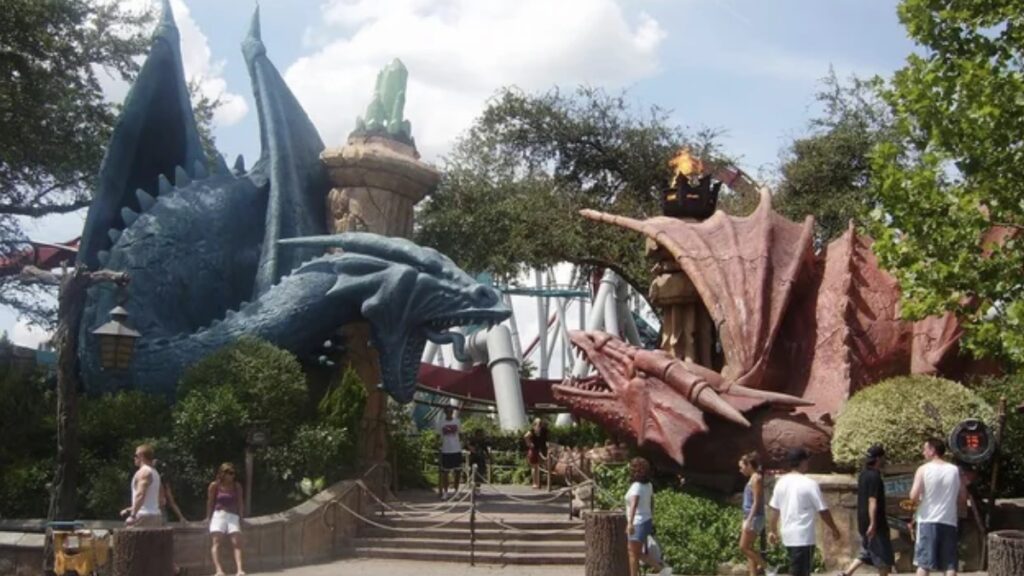
“Dragon’s Tower” becomes “Dueling Dragons”
Anywho, back to Islands of Adventure … is “Dueling Dragons” an obvious rip-off of “Beastly Kingdom”‘s proposed “Dragon’s Tower” ride? Perhaps. But how can you rip off something that hasn’t actually been built yet?
Some might argue that Universal — being the first theme park company to build a mega-coaster that featured a dragon storyline with a queue area that was themed around a decrepit castle — must now get credit for creating that attraction. Which means Universal effectively owns that ride idea. That would mean that — should Disney ever go forward with their “Dragon’s Tower” attraction idea — the Mouse would now appear to be copying ride ideas from Universal, rather than the other way around.
Never mind that Disney came up with the original idea for a dragon-based coaster. Never mind that Universal may have acquired the concept for their dragon coaster attraction under somewhat questionable circumstances. In the end, all that matters is: Who built the ride first? Since Universal was the first to build a dragon-based coaster, that ride concept now belongs to them.
“Beastly Kingdom” Loses Its Icon – Land Cancelled
And — since Eisner didn’t want it to appear as if Disney was stealing ride ideas from Universal — he asked the Imagineers to remove the “Dragon’s Tower” ride from all future plans for “Beastly Kingdom.” But — without the tumble-down burned-out castle (that would have served as “Dragon’s Tower”‘s show building) to serve as the centerpiece for this proposed addition to WDW’s fourth theme park — “Beastly Kingdom” was left without a “weenie,” a strong visual element that would lure people down into this side of the park. Without “Dragon’s Tower,” “Beastly Kingdom” now seemed kind of pointless.
Dinoland USA Expansion
As painful as it might be, Joe Rohde and his Imagineering team now had to face facts. “Beastly Kingdom” — as they had originally planned it — was dead. WDI would now have to abandon all the witty plans they’d come up with for this part of the park and dream up some new attractions for DAK’s east side.
Mind you, there was no time to mourn “Beastly Kingdom”‘s demise. Rohde and his team were too busy fighting with Disney management over their bargain basement expansion plans for DAK’s Dinoland USA. Assuming that — when Disney’s “Dinosaur” movie opens in theaters later this month — this side of the park will see a huge surge of new traffic, Eisner ordered that several lightly themed off-the-shelf carnival-style rides be added to Dinoland USA to increase capacity.
Rohde was said to be furious when he learned of this plan, particularly since WDI had already put together an elegant expansion plan for DAK’s dino area. He’s reportedly particularly enraged that the name that his Imagineering team came up with for a runaway-mine-car-through-an-abandoned-dinosaur-dig ride — the Excavator — for Dinoland USA’s “Phase II” will now be used for a smallish kiddie coaster Eisner is quickly tossing into the area.
Adding to Rohde’s aggravation: DAK’s ‘temporary’ area — Camp Minnie-Mickey — was becoming all the more permanent as each day went by. Exit polls showed that this area’s “Festival of the Lion King” show was the most popular attraction in all of Animal Kingdom. So popular that Disney had to add additional seats to DAK’s “Lion King” theater to increase the show’s capacity. And — with “Lion King III,” another direct-to-video sequel to the original 1994 film, currently in the works — it could now be years before the “Lion King” phenomenon finally fades … leaving all the land around that once-thought-to-be-temporary theater available again for development.
As you can see, Rohde and his Imagineers didn’t have time to moan over “Beastly Kingdom”‘s loss. They’re too busy fighting with Disney Company management, trying to keep Eisner and Co. from ruining the park with their bone-headed cost-cutting maneuvers.
Editor’s Note: This article is an adaptation of the original three-part series from Jim Hill Media, “Is DAK’s Beastly Kingdom DOA?” (December 2000). Pandora – The World of Avatar officially opened at Disney’s Animal Kingdom on May 27, 2017, in the area originally proposed for Beastly Kingdom.
Will There Ever Be a “Beastly Kingdom” at Walt Disney World?
But is “Beastly Kingdom” really dead? At least for the immediate future, it would seem so. Any ambitious plans the Mouse may have had for expansion of Disney’s Animal Kingdom are now completely on hold.
Why for? Because there’s so much other stuff at DAK that’s currently in urgent need of repair. For example: Conservation Station is thought to be a complete disaster. Visitors repeatedly name that area as their least favorite part of Disney’s Animal Kingdom. So the Imagineers are frantically searching for ways to fix up that facility.
And then there’s Kali River Rapids. Though only a year old, the centerpiece attraction for DAK’s Asia area is already falling apart. There are currently so few of that attraction’s original rafts in working condition that visitors often have to wait as much as an hour in line before there’s a raft available for them to board.
But all those Disney unicorn and dragon lovers out there shouldn’t completely lose heart. Long-time Disney theme park observers know it’s wise never to consider a really great concept for a theme park show or attraction completely dead. For the Imagineers have this awful tendency to recycle abandoned ideas.
Consider Disneyland’s long proposed Discovery Bay. Though Tony Baxter hatched the concept for this Jules Verne-meets-Gold Rush-era-San-Francisco Frontierland expansion back in 1977, it wasn’t until 1992 that elements of this proposed Disneyland addition finally turned up in a Disney theme park. Unfortunately for all those US-based Discovery Bay fans, the park that got the land (DiscoveryLand, to be exact) that was inspired by Tony’s concept art was Disneyland – Paris. But some of Discovery Bay did finally make it off the drawing board.
So who knows? Maybe in ten years or so, some Imagineer may come with a clever way to rework the “Dragon’s Tower” storyline. Perhaps that long rumored South American Disney theme park will have a Sleeping Beauty’s castle with a thrill ride — rather than a walking tour — as its main attraction? Maybe this thrill ride will feature a huge AA version of the Maleficent dragon, snarling and breathing fire at riders as they whiz through the attraction’s finale? Stranger things have happened, kids.
Here’s hoping that — some day, in some way — dragons and unicorns turn up in a Disney theme park.
After all, there’s always room for a little more magic in the Magic Kingdom.
Want more behind-the-scenes Disney stories? Dive deeper into the magic with The Disney Dish podcast, where Jim Hill and Len Testa explore Disney news and park history. Listen now at The Disney Dish on Apple Podcasts. For exclusive bonus episodes and even more insider content, check out Disney Unpacked on Patreon.
History
The Super Bowl & Disney: The Untold Story Behind ‘I’m Going to Disneyland!’

One of the highlights of the Super Bowl isn’t just the game itself—it’s the moment when the winning quarterback turns to the camera and exclaims, “I’m going to Disney World!” This now-iconic phrase has been a staple of post-game celebrations for decades. But where did this tradition begin? Surprisingly, it didn’t originate in a stadium but at a dinner table in 1987, in a conversation involving Michael Eisner, George Lucas, and aviation pioneers Dick Rutan and Jeana Yeager.
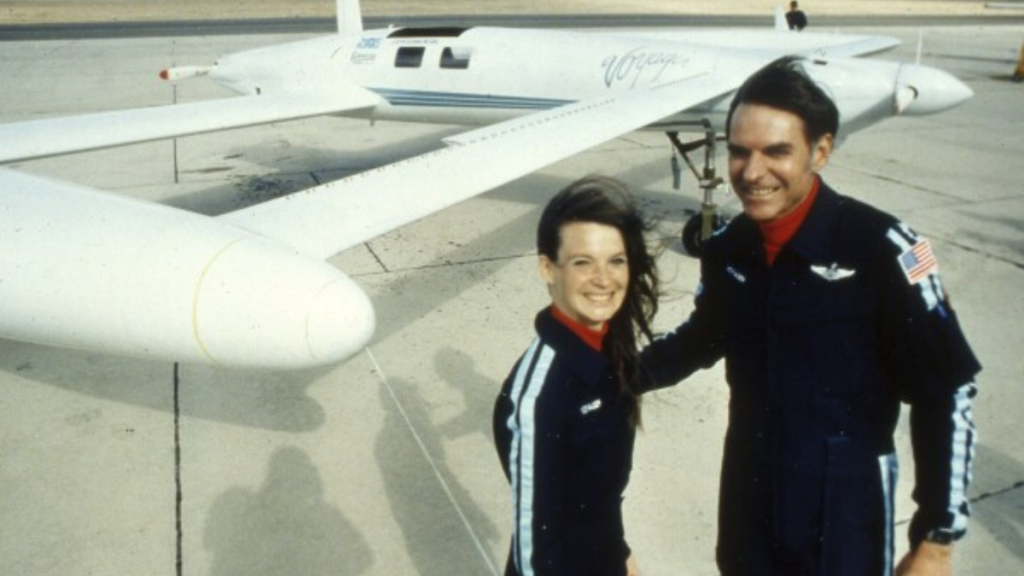
The Unlikely Beginning of a Marketing Sensation
To understand the origins of this campaign, we have to go back to December 1986, when the Rutan Voyager became the first aircraft to fly around the world without stopping or refueling. Pilots Dick Rutan and Jeana Yeager completed the nine-day journey on December 23, 1986, flying over 26,000 miles before landing at Edwards Air Force Base. Their historic achievement earned them national recognition, and just days later, President Ronald Reagan awarded them the Presidential Citizen Medal at the White House.
Meanwhile, Disney was gearing up for the grand opening of Star Tours at Disneyland, set for January 12, 1987. Following its usual playbook of associating major theme park attractions with real-world pioneers, Disney’s PR team invited astronauts Gordon Cooper and Deke Slayton to the launch event. But in a twist, they also invited Rutan and Yeager, who were still making headlines.
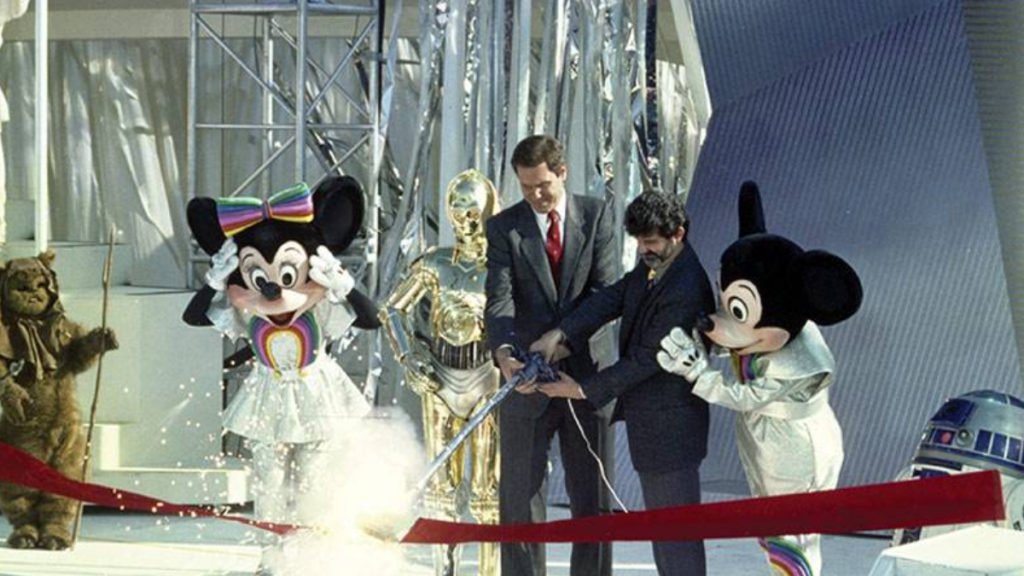
A Dinner Conversation That Changed Advertising Forever
After the Star Tours opening ceremony, a private dinner was held with Disney CEO Michael Eisner, George Lucas, and Eisner’s wife, Jane. During the meal, Eisner asked Rutan and Yeager, “You just made history. You traveled non-stop around the planet on a plane without ever refueling. How are you ever going to top that, career-wise? What are you two gonna do next?”
Without hesitation, Jeana Yeager replied, “Well, after being cramped inside that tiny plane for nine days, I’m just glad to be anywhere else. And even though you folks were nice enough to fly us here, invite us to your party… Well, as soon as we finish eating, I’m gonna go over to the Park and ride some rides. I’m going to Disneyland.”
Jane Eisner immediately recognized the power of Yeager’s statement. On the car ride home, she turned to Michael and said, “That’s a great slogan. I think you should use that to promote the theme parks.” Like many husbands, Michael initially dismissed the idea, but Jane persisted. Eventually, Eisner relented and pitched it to his team.
The Super Bowl Connection
With Super Bowl XXI just around the corner, Disney’s PR team saw an opportunity. The game was set for January 25, 1987, at the Rose Bowl in Pasadena—just miles from Disney Studios. What if they convinced the winning quarterback to say, “I’m going to Disneyland” live on-air?
Disney quickly struck a deal with both quarterbacks—Phil Simms of the New York Giants and John Elway of the Denver Broncos—offering each $75,000 to deliver the line if their team won. Simms led the Giants to victory, making history as the first athlete to say, “I’m going to Disney World!” on national television.
A Marketing Triumph
That year’s Super Bowl had the second-highest viewership in television history, with 87 million people watching Simms say the famous line. The next day, Disney turned the clip into a national commercial, cementing the phrase as a marketing goldmine.
Since then, “I’m going to Disneyland” (or Disney World, depending on the commercial) has been a staple of championship celebrations, spanning the NFL, NBA, and even the Olympics. What started as a casual remark at dinner became one of the most successful advertising campaigns in history.
A Lasting Legacy
Jane Eisner’s keen instinct and Disney’s ability to act quickly on a great idea created a tradition that continues to captivate audiences. The “I’m going to Disneyland” campaign remains a testament to the power of spontaneous inspiration and smart marketing, proving that sometimes, the best ideas come from the most unexpected places.
To learn more about Disney’s ties to the world of sports, check out I Want That Too: A Disney History and Consumer Product Podcast.
-

 Theme Parks & Themed Entertainment9 months ago
Theme Parks & Themed Entertainment9 months agoDisney’s Forgotten Halloween Event: The Original Little Monsters on Main Street
-

 Theme Parks & Themed Entertainment9 months ago
Theme Parks & Themed Entertainment9 months agoThe Story of Mickey’s Not-So-Scary Halloween Party: From One Night to a Halloween Family Tradition
-

 Film & Movies9 months ago
Film & Movies9 months agoHow “An American Tail” Led to Disney’s “Hocus Pocus”
-

 Theme Parks & Themed Entertainment7 months ago
Theme Parks & Themed Entertainment7 months agoDisney and Macy’s 90-Year Thanksgiving Day Parade Partnership: From Mickey’s First Balloon to Minnie’s Big Debut
-

 Television & Shows5 months ago
Television & Shows5 months agoHow the Creators of South Park Tricked A-List Celebrities to Roast Universal – “Your Studio & You”
-
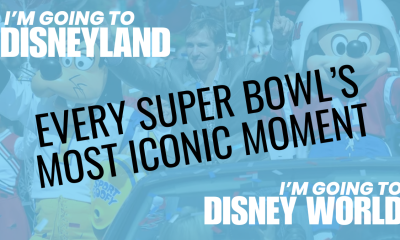
 History4 months ago
History4 months agoThe Super Bowl & Disney: The Untold Story Behind ‘I’m Going to Disneyland!’
-
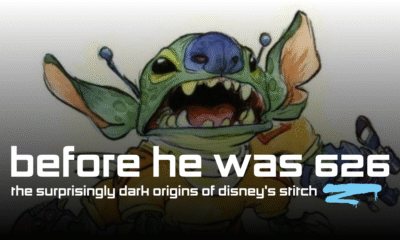
 Film & Movies3 weeks ago
Film & Movies3 weeks agoBefore He Was 626: The Surprisingly Dark Origins of Disney’s Stitch
-

 Podcast2 months ago
Podcast2 months agoEpic Universal Podcast – Aztec Dancers, Mariachis, Tequila, and Ceremonial Sacrifices?! (Ep. 45)








